Premium courses offered by Wray Castle Ltd are designed for professionals seeking advanced knowledge and skills in telecommunications and technology. These courses are tailored to provide in-depth, specialized training in specific areas such as 5G, LTE, IP, radio engineering, network virtualization, and critical communications like TETRA and PMR.
With a focus on delivering high-quality, industry-relevant content, premium courses are ideal for individuals looking to enhance their expertise and advance their careers in the rapidly evolving field of telecommunications. These courses are developed by industry experts with years of experience, ensuring that learners receive the most up-to-date and relevant information.
By enrolling in a premium course, participants can expect to gain a deep understanding of complex topics, explore advanced concepts, and develop practical skills that can be applied in real-world scenarios. The courses are delivered through a combination of live sessions, self-paced modules, interactive labs, and case studies, allowing learners to engage with the material in a variety of ways.
One of the key benefits of premium courses is the personalized support and guidance provided by experienced tutors. Learners have the opportunity to ask questions, seek clarification, and receive feedback on their progress, ensuring that they are able to fully grasp the material and apply it effectively in their work.
Upon successful completion of a premium course, participants will receive a digital badge certifying their achievement. This recognition can enhance their professional profile, demonstrate their expertise to employers, and open up new opportunities for career advancement.
Overall, premium courses offered by Wray Castle Ltd are a valuable investment for professionals looking to stay ahead in the fast-paced world of telecommunications and technology. With access to cutting-edge content, expert guidance, and industry recognition, learners can take their skills to the next level and achieve their career goals.
Premium Courses
-
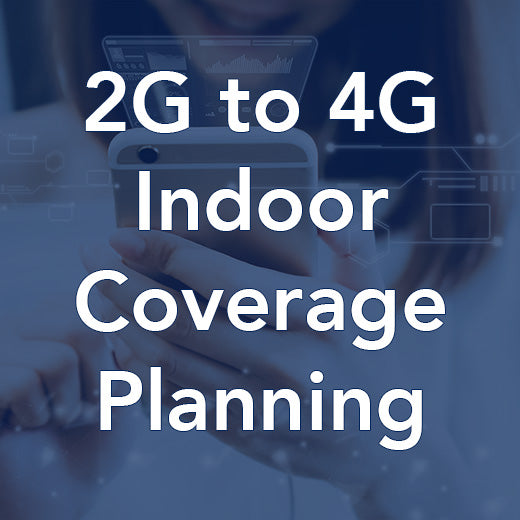
2G to 4G Indoor Coverage Planning
Course Code: MB1304 Course Summary This 2G to 4G Indoor Coverage Planning course is intended for experienced cell planners wishing to move into indoor coverage planning. The course details all of the issues of indoor planning from initial site survey to integration. This 2G to 4G Indoor Coverage Planning course is designed for experienced cell planners looking to transition into indoor coverage planning. From initial site surveys to integration, this course covers all aspects of indoor planning in detail. Participants will gain valuable insights into indoor propagation considerations, calculating indoor coverage, equipment for measuring coverage, methods for providing coverage, passive and active DAS, indoor antennas, link budget calculations, handover parameters, MIMO configurations, and coverage in challenging environments like elevators and trains. Practical planning exercises are also included to enhance learning and application of the concepts covered.Ideal for experienced cell planners seeking to expand their expertise into indoor coverage planning, as well as individuals who need to understand the complexities of indoor planning issues, this course offers a comprehensive overview of the planning process for GSM, UMTS, and LTE networks. Previous attendance on the Cell Planning for UMTS Networks and Cell Planning for LTE Networks courses is advantageous for participants looking to maximize their learning outcomes. Who would benefit Experienced cell planners wishing to move into indoor coverage planning, as well as those who need to understand indoor planning issues. Prerequisites Previous attendance on the Cell Planning for UMTS Networks course (MB2005) and Cell Planning for LTE Networks (LT2901) is advantageous. Topic Areas Include The planning process Initial planning and site survey Traffic dimensioning for GSM, UMTS and LTE Indoor propagation considerations Calculating indoor coverage Equipment for measuring indoor coverage Methods for providing indoor coverage Passive DAS Active DAS Indoor antennas Link budget calculations for GSM, UMTS and LTE Handover and cell reselection parameters for GSM, UMTS and LTE MIMO configurations Coverage in elevators and trains Includes practical planning exercises.
POA: Private Course
-
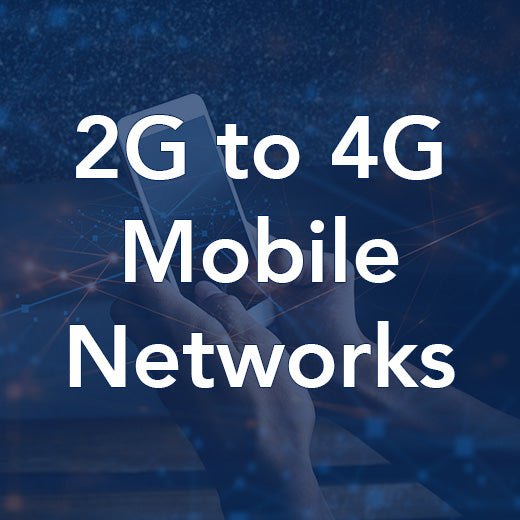
2G to 4G Mobile Networks
Course Code: MB1404 Course Overview This 2G to 4G Mobile Networks training course offered by Wray Castle provides a comprehensive technical overview of key cellular technologies, including 2G GSM, GPRS, 3G UMTS, and 4G LTE, all in one convenient package. Designed for technical professionals who need a solid understanding of these technologies without the need to delve into each one separately, this course is ideal for engineers, technical sales representatives, technical managers, and other staff members looking to gain a broad understanding of modern mobile technologies.Participants in this course do not need any specific prerequisites other than the ability to grasp technical information, making it accessible to a wide range of individuals interested in expanding their knowledge of mobile networks. The curriculum covers essential topics such as PSTN overview, SS7 signaling basics, call control signaling, GSM CS domain interfaces and protocols, UMTS architecture, LTE, and more. By the end of the training, attendees will have a solid foundation in 2G to 4G mobile networks, enabling them to better navigate the complexities of modern cellular technologies in their professional roles. Who Would Benefit This course is suitable for engineering, technical sales, technical management and other staff who require a general technical overview of modern mobile technologies but who do not need to invest the time necessary to learn about each technology in depth. Prerequisites This is a technical foundation course. Candidates do not need any specific prerequisites other than the ability to grasp technical information. Course Contents PSTN Overview SS7 Signalling Basics Call Control Signalling, ISUP and SCCP 2G Circuit Switched Domain GSM CS Domain Interfaces and Protocols CAMEL GPRS UMTS Architecture Overview UMTS Air Interface UMTS Circuit Switched Core – Protocols and Procedures UMTS Packet Switched Core – Protocols and Procedures LTE
POA: Private Course
-
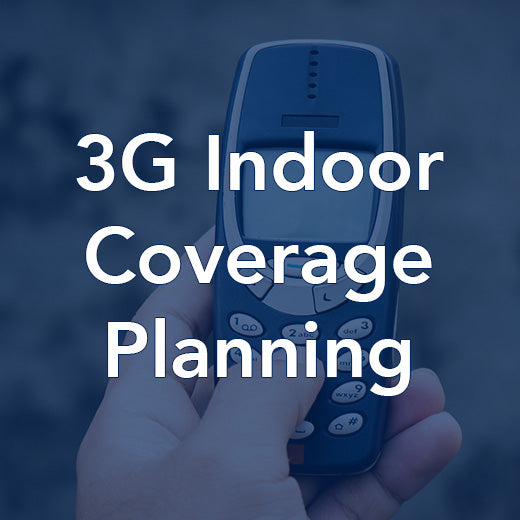
3G Indoor Coverage Planning
Course Summary Enhance your skills in 3G indoor coverage planning with our comprehensive training course. Designed for experienced GSM indoor planners looking to transition into WCDMA coverage, this course covers various indoor scenarios and planning techniques to provide you with the knowledge and expertise needed in indoor UMTS coverage. Ideal for engineers moving into UMTS indoor coverage or those working in planning-related roles, this course delves into topics such as traffic dimensioning, propagation modeling, link budgets, antenna positioning, and more. With practical planning exercises included, you will gain hands-on experience to apply your learnings in real-world scenarios.Don't miss this opportunity to advance your career in indoor coverage planning. Who would benefit Experienced GSM indoor planning engineers moving into UMTS indoor coverage, as well as those working in planning-related areas or needing to understand UMTS planning considerations. Prerequisites Attendees should already have knowledge and experience of GSM indoor coverage planning. Previous attendance on the UMTS Air Interface course (MB2002) is advantageous. Topic Areas Include: Traffic dimensioning Office and corporate scenarios Shopping centres Packet-switched traffic Propagation modelling Measurements Link budgets Antenna positioning Tunnels Stadiums RF safety (ICNIRP) Picocells Repeaters Femtocells Distributed antennas Fibre distribution Integrating indoor cells Includes practical planning exercises.
POA: Private Course
-
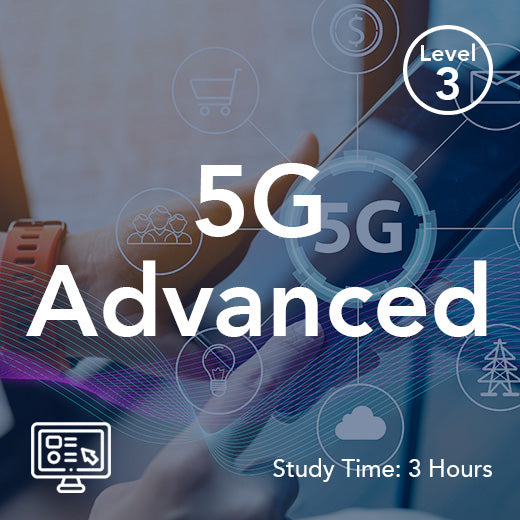
5G Advanced (On-Demand)
5G Advanced On-Demand is a comprehensive course designed to explore the latest advancements in 5G technology, specifically focusing on the enhancements introduced in 3GPP Release 18. This course delves into how 5G Advanced significantly boosts network capabilities, paving the way for future demands and innovations in the telecommunications industry. By understanding the specific features and improvements that 5G Advanced brings to the table, telecom professionals, network engineers, product managers, and individuals involved in strategic planning or technical implementation can stay ahead of the curve and leverage these advancements to drive success in their respective industries. With a concise overview of the enhancements introduced by 5G Advanced, participants will gain valuable insights into how these improvements can revolutionize their current practices and infrastructure. From base capability improvements to specific features unique to 5G Advanced, this course covers a wide range of topics essential for professionals looking to stay informed and competitive in the rapidly evolving telecommunications landscape. Whether you are looking to enhance your technical knowledge or gain a strategic edge in your industry, 5G Advanced On-Demand offers the knowledge and expertise needed to thrive in the era of advanced connectivity and communication technologies. Who Would Benefit This course is ideal for telecom professionals, network engineers, product managers, and anyone involved in strategic planning or technical implementation within telecommunications and related industries who require a concise overview of the improvements 5G Advanced introduces, along with an examination of the specific features and how they enhance their respective industries. Course Contents Introduction 5G Advanced – Base Capability Improvements Specific 5G Advanced Features
£95.00
-
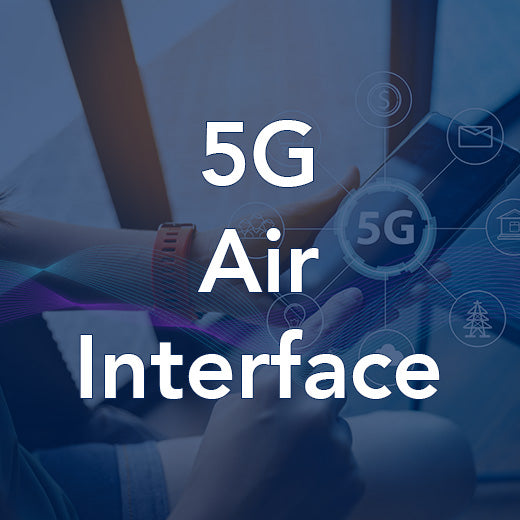
5G Air Interface
Our 5G Air Interface training course provides a comprehensive technical overview of the air interface for the 5G New Radio (5G NR). This course delves into the principles of millimetre wave and multiple antenna communications, the architecture and implementation of the air interface's physical layer, as well as the higher layer air interface protocols and signalling procedures for both idle and active 5G devices. Ideal for engineers and professionals involved in equipment design, operation, optimization, or monitoring on the 5G air interface, this course assumes an engineering background with some knowledge of general radio principles and digital radio systems. While a basic understanding of 5G and experience with LTE radio systems are desirable, they are not mandatory prerequisites.In addition to the 2-day course covers a range of topic areas including 5G introduction, use cases, and standardization, radio spectrum and millimetre wave communications, principles and implementation of multiple antennas in 5G, and more. For those looking to deepen their understanding further, we also offer an optional 5G Virtual Lab Module where participants can explore, test, optimize, and troubleshoot the 5G system in a fully emulated environment. Join us to enhance your knowledge and skills in the dynamic world of 5G technology. Who would benefit The course is intended for engineers and other staff who are involved with equipment design, operation, optimization or monitoring on the 5G air interface. Prerequisites An engineering background with some knowledge of general radio principles and digital radio systems is assumed. A basic understanding of 5G and experience of LTE radio systems would be desirable. Topic Areas Include: 5G introduction, use cases and standardisation Radio spectrum and millimetre wave communications Principles and implementation of multiple antennas in 5G Architecture of the air interface physical layer Details and implementation of the 5G physical, transport and logical channels Air interface procedures for synchronisation, scheduling, data transmission, feedback and random access Dual connectivity architecture and protocol stacks Optional 5G Virtual Lab Module Explore, Test, Optimise, and Troubleshoot the 5G System Deep dive into the key signalling scenarios in the 5G system and analyse the output to build a deeper understanding that goes beyond the theoretical. The lab is a fully emulated 5G System environment that enables you to experiment with the configurations for Network Functions and build customized settings for signalling scenarios that helps you to develop greater insight into the operation of the 5G System. Lab modules can be added to any relevant 5G course. Learn more and arrange a demo. Also available as a Self-Study Online learning programme, learn more.
POA: Private Course
-
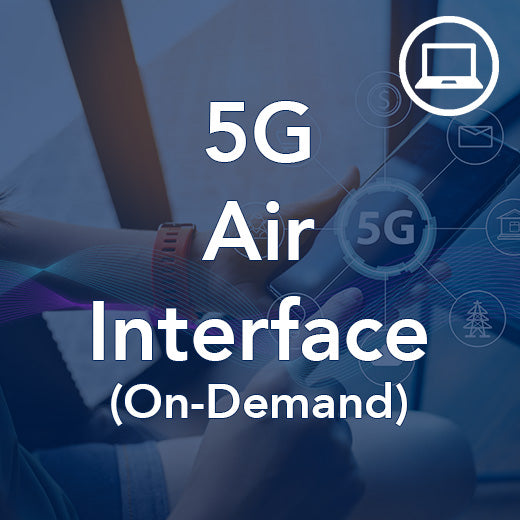
5G Air Interface (On-Demand)
Our 5G Air Interface training course provides a comprehensive technical overview of the air interface for the 5G New Radio (5G NR). This course delves into the principles of millimetre wave and multiple antenna communications, the architecture and implementation of the air interface's physical layer, as well as the higher layer air interface protocols and signalling procedures for both idle and active 5G devices. Ideal for engineers and professionals involved in equipment design, operation, optimization, or monitoring on the 5G air interface, this course assumes an engineering background with some knowledge of general radio principles and digital radio systems. While a basic understanding of 5G and experience with LTE radio systems are desirable, they are not mandatory prerequisites.In addition our course covers a range of topic areas including 5G introduction, use cases, and standardization, radio spectrum and millimetre wave communications, principles and implementation of multiple antennas in 5G, and more. For those looking to deepen their understanding further, we also offer an optional 5G Virtual Lab Module where participants can explore, test, optimize, and troubleshoot the 5G system in a fully emulated environment. This self-paced on-demand distance learning course features illustrated course books, videos, tests and full tutor support. Who would benefit The course is intended for engineers and other staff who are involved with equipment design, operation, optimization or monitoring on the 5G air interface. Prerequisites An engineering background with some knowledge of general radio principles and digital radio systems is assumed. A basic understanding of 5G and experience of LTE radio systems would be desirable. Topic Areas Include: 5G introduction, use cases and standardisation Radio spectrum and millimetre wave communications Principles and implementation of multiple antennas in 5G Architecture of the air interface physical layer Details and implementation of the 5G physical, transport and logical channels Air interface procedures for synchronisation, scheduling, data transmission, feedback and random access Dual connectivity architecture and protocol stacks Also available as a Live Online Training Programme, learn more.
£1,815.00
-
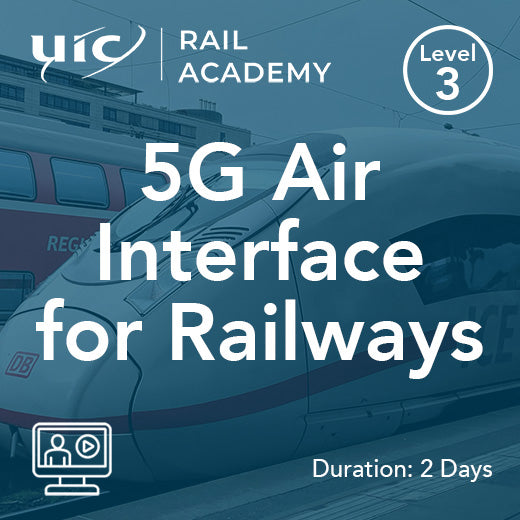
5G Air Interface for Railways
This 5G Air Interface for Railways training course is a detailed technical description of the air interface for the 5G New Radio (5G NR). It covers the principles of millimetre wave and multiple antenna communications, the architecture and implementation of the air interface’s physical layer, the higher layer air interface protocols, and the signalling procedures for idle and active 5G devices. With the emergence of FRMCS our 5G Rail portfolio addresses the technical requirements of FRMCS. Who would benefit The course is intended for engineers and other staff who are involved with equipment design, operation, optimization or monitoring on the 5G air interface. Prerequisites An engineering background with some knowledge of general radio principles and digital radio systems is assumed. A basic understanding of 5G and experience of LTE radio systems would be desirable. Topic Areas Include: 5G introduction, use cases and standardisation Radio spectrum and millimetre wave communications Principles and implementation of multiple antennas in 5G Architecture of the air interface physical layer Details and implementation of the 5G physical, transport and logical channels Air interface procedures for synchronisation, scheduling, data transmission, feedback and random access Dual connectivity architecture and protocol stacks
POA: Private Course
-
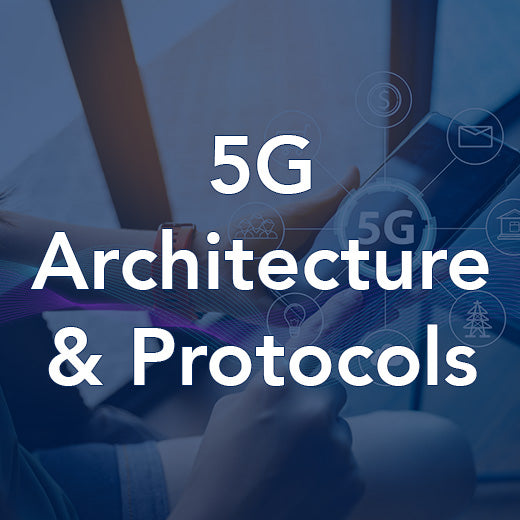
5G Architecture and Protocols
Course Code: FG1715 This 5G Architecture and Protocols training course is a detailed technical description of the core and radio access networks of 5G. It covers the architecture and interfaces used by 5G, the protocols used for signalling and data transport, the provision of services over a 5G network, and the procedures for signalling and system operation. Who would benefit The course is intended for engineers and other staff who are involved with the architecture, optimization, management, monitoring or testing of the 5G network. Prerequisites An engineering background with some knowledge of core and radio access network technologies is assumed. A basic understanding of 5G and experience of LTE networks would be desirable. Topic Areas Include: 5G introduction, use cases and standardisation Radio access network architecture and deployment options Network architectures for dual connectivity Architecture of the 5G core network Network Function virtualisation, slicing and orchestration Interworking and compatibility between 5G, LTE and Wi-Fi PDU connectivity, Quality of Service and service provision Control plane and user plane protocols in the 5G network Implementation of network function services using HTTP/2 Signalling procedures for registration, security and session management Network operation in Idle, Inactive and Connected modes Optional 5G Virtual Lab Module Explore, Test, Optimise, and Troubleshoot the 5G System Deep dive into the key signalling scenarios in the 5G system and analyse the output to build a deeper understanding that goes beyond the theoretical. The lab is a fully emulated 5G System environment that enables you to experiment with the configurations for Network Functions and build customized settings for signalling scenarios that helps you to develop greater insight into the operation of the 5G System. Lab modules can be added to any relevant 5G course. Learn more and arrange a demo. Trainer: Tony Wakefield Tony is an experienced technical trainer and competency development specialist having worked with a diverse and extensive base of companies. He has spoken at global conferences and has extensive experience in facilitating programmes, specialising in 5G and the wider aspects of telecoms and connected innovation. Also available as a Self-Study Online Learning Programme, learn more.
POA: Private Course
-
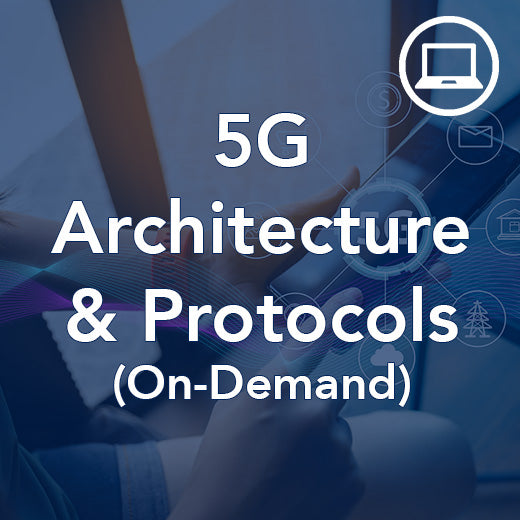
5G Architecture and Protocols (On-Demand)
This 5G Architecture and Protocols on-demand course is a detailed technical description of the core and radio access networks of 5G. It covers the architecture and interfaces used by 5G, the protocols used for signalling and data transport, the provision of services over a 5G network, and the procedures for signalling and system operation. This self-paced on-demand distance learning course features illustrated course books, videos, tests and full tutor support. Who would benefit The course is intended for engineers and other staff who are involved with the architecture, optimization, management, monitoring or testing of the 5G network. Prerequisites An engineering background with some knowledge of core and radio access network technologies is assumed. A basic understanding of 5G and experience of LTE networks would be desirable. Topic Areas Include: 5G introduction, use cases and standardisation Radio access network architecture and deployment options Network architectures for dual connectivity Architecture of the 5G core network Network Function virtualisation, slicing and orchestration Interworking and compatibility between 5G, LTE and Wi-Fi PDU connectivity, Quality of Service and service provision Control plane and user plane protocols in the 5G network Implementation of network function services using HTTP/2 Signalling procedures for registration, security and session management Network operation in Idle, Inactive and Connected modes
£1,815.00
-
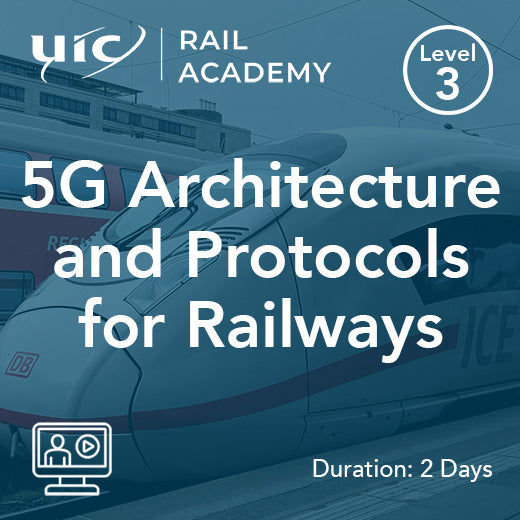
5G Architecture and Protocols for Railways
This 5G Architecture and Protocols for Railways training course is a detailed technical description of the core and radio access networks of 5G. It covers the architecture and interfaces used by 5G, the protocols used for signalling and data transport, the provision of services over a 5G network, and the procedures for signalling and system operation. With the emergence of FRMCS our 5G Rail portfolio addresses the technical requirements of FRMCS. Who would benefit The course is intended for engineers and other staff who are involved with the architecture, optimization, management, monitoring or testing of the 5G network. Prerequisites An engineering background with some knowledge of core and radio access network technologies is assumed. A basic understanding of 5G and experience of LTE networks would be desirable. Topic Areas Include: 5G introduction, use cases and standardisation Radio access network architecture and deployment options Network architectures for dual connectivity Architecture of the 5G core network Network Function virtualisation, slicing and orchestration Interworking and compatibility between 5G, LTE and Wi-Fi PDU connectivity, Quality of Service and service provision Control plane and user plane protocols in the 5G network Implementation of network function services using HTTP/2 Signalling procedures for registration, security and session management Network operation in Idle, Inactive and Connected modes Optional 5G Virtual Lab Module Explore, Test, Optimise, and Troubleshoot the 5G System Deep dive into the key signalling scenarios in the 5G system and analyse the output to build a deeper understanding that goes beyond the theoretical. The lab is a fully emulated 5G System environment that enables you to experiment with the configurations for Network Functions and build customized settings for signalling scenarios that helps you to develop greater insight into the operation of the 5G System. Lab modules can be added to any relevant 5G course. Learn more and arrange a demo.
POA: Private Course
-
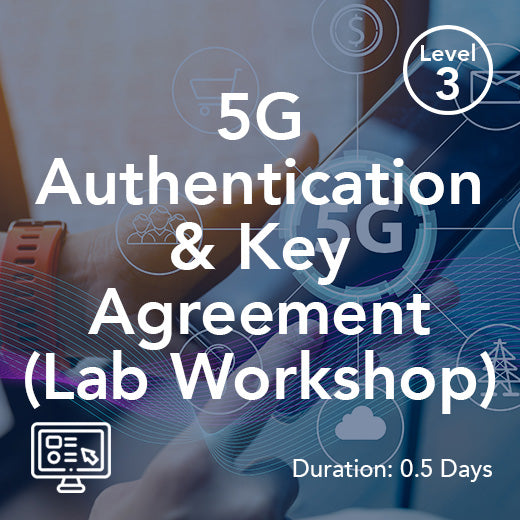
5G Authentication and Key Agreement (Lab Workshop)
This lab enables you to explore the 5G Authentication & Key Agreement procedure with our 1/2-day lab including ciphering key and integrity key generation The cloud-based lab provides participants with access to a fully emulated 5G System environment. Experiment with the configurations for various Network Functions within the 5G Core Network and build customized settings for signalling scenarios that will enable users to develop greater insight in to the operation of the 5G System. 5G Authentication & Key Agreement Examine the 5G AKA procedure including ciphering key and integrity key generation AMF/SEAF signalling towards AUSF using HTTPv2 protocol Usage of SIDF in UDM ARPF and its usage for creation of Authentication Vector Lab Features & Benefits Through a combination of hands-on experience and guided instruction our virtual labs allow users to explore signalling procedures in the 5G system. Our labs feature: A simulated 5G network - Provides hands-on experience and reinforces theoretical knowledge. Guided exercises for signalling scenarios - makes learning and applying new concepts straightforward. Wireshark (pcap) output files – detailed output files provide deep system insight. Cloud-based lab - available 24/7 on any connected device. Individual dedicate server - Ensures that your work is kept private and secure. Ongoing trainer support - ensures you get expert advice when needed. Full integration with Wray Castles training programmes - allows you to build bespoke learning pathways for specialist teams across your organisation. You can find more information on our labs and arranges a demo here.
POA: Private Course
-
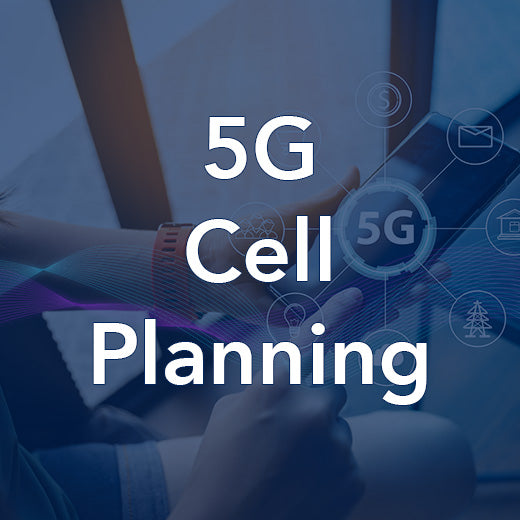
5G Cell Planning
Our 5G Cell Planning training course is designed to provide network planning engineers with the essential knowledge and skills needed to effectively plan radio access networks for 5G. Through practical worked examples and in-depth discussions, participants will gain a solid understanding of coverage and capacity estimations, RF KPIs, signal measurements, and parameters that impact the random access process. By the end of the course, students will be equipped with the theoretical knowledge and practical tools to confidently plan 5G cells and optimize network performance. Whether you are new to 5G cell planning or looking to enhance your existing skills, this training programme is suitable for anyone with a background in telecommunication systems and radio network planning. Join us and take your 5G cell planning expertise to the next level. Don't miss out on the opportunity to advance your career in 5G cell planning. Enroll in our live online training course today and gain valuable insights into the fundamentals of the 5G air interface, link budget estimation, coverage estimation, capacity estimation, and more. For a self-paced learning option, check out our On-Demand Training Programme and start mastering 5G cell planning at your own pace. Who Would Benefit This course is intended for network planning engineers, who wish to learn about the issues that are involved when planning radio access networks for 5G. Prerequisites The course assumes familiarity with telecommunication systems and with the principles of radio network planning. Some understanding of radio network planning for LTE, and of the 5G air interface, would be beneficial. Topic Areas Include Fundamentals of the 5G Air Interface Link Budget Estimation Coverage Estimation Capacity Estimation RSRP, RSRQ and SINR Parameter Setting Also available as a Self-Paced Online Training Programme, learn more.
POA: Private Course
-
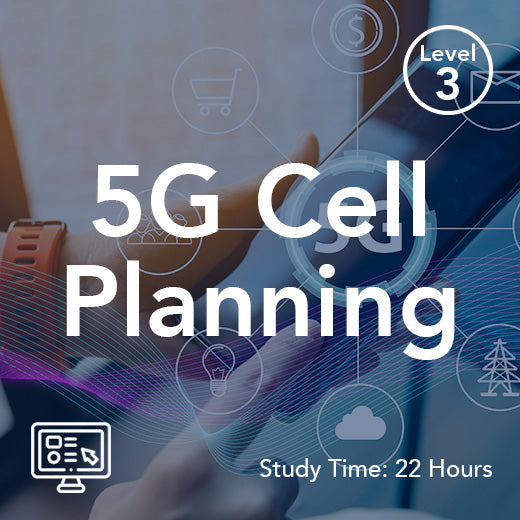
5G Cell Planning (On-Demand)
Our 5G Cell Planning training course is designed to provide network planning engineers with the essential knowledge and skills needed to effectively plan radio access networks for 5G. Through practical worked examples and in-depth discussions, participants will gain a solid understanding of coverage and capacity estimations, RF KPIs, signal measurements, and parameters that impact the random access process. By the end of the course, students will be equipped with the theoretical knowledge and practical tools to confidently plan 5G cells and optimize network performance. Whether you are new to 5G cell planning or looking to enhance your existing skills, this training programme is suitable for anyone with a background in telecommunication systems and radio network planning. Join us and take your 5G cell planning expertise to the next level. Don't miss out on the opportunity to advance your career in 5G cell planning. Enroll in our live online training course today and gain valuable insights into the fundamentals of the 5G air interface, link budget estimation, coverage estimation, capacity estimation, and more. For a self-paced learning option, check out our On-Demand Training Programme and start mastering 5G cell planning at your own pace. This self-paced on-demand distance learning course features illustrated course books, videos, tests and full tutor support. Who Would Benefit This course is intended for network planning engineers, who wish to learn about the issues that are involved when planning radio access networks for 5G. Prerequisites The course assumes familiarity with telecommunication systems and with the principles of radio network planning. Some understanding of radio network planning for LTE, and of the 5G air interface, would be beneficial. Topic Areas Include Fundamentals of the 5G Air Interface Link Budget Estimation Coverage Estimation Fundamentals of the 5G Air Interface Link Budget Estimation Coverage Estimation
£750.00
-
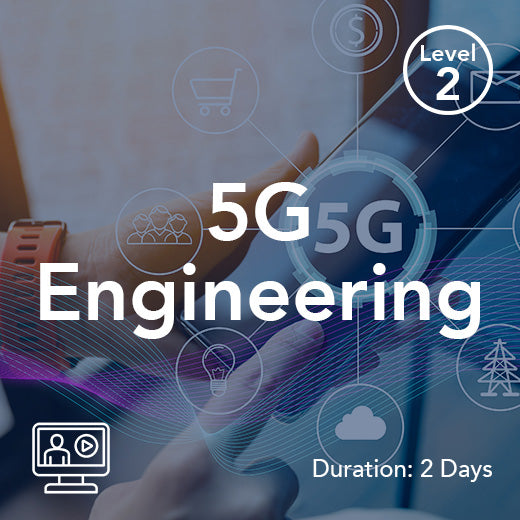
5G Engineering
5G Engineering training course provides a comprehensive technical introduction to the world of 5G. From understanding the design goals and development schedule for 5G to delving into the principles, design, and implementation of the 5G air interface, radio access network, and core network, this course covers it all. Perfect for engineers new to or already working in mobile communications, this course assumes familiarity with telecommunications and general engineering terminology, with some understanding of LTE cellular systems being beneficial. Our course covers a wide range of topic areas, including 5G introduction, key features, and standardization, use cases and performance objectives, principles of the air interface such as radio spectrum, OFDMA, and multiple antennas, air interface protocol stack, architecture of the air interface physical layer, procedures for data transmission and reception on the 5G air interface, radio access network architecture and protocols, core network architecture and protocols, network function virtualization and network slicing, interworking and compatibility between 5G, LTE, and Wi-Fi, PDU connectivity, Quality of Service, service provision, and signalling procedures in the 5G network. Join us for this in-depth course and take your knowledge of 5G to the next level. Who would benefit This course is intended for engineers either new to, or already working in, mobile communications. Prerequisites Familiarity with telecommunications and general engineering terminology is assumed. Some understanding of LTE cellular systems would be beneficial. Topic Areas Include 5G introduction, key features and standardisation Use cases and performance objectives Principles of the air interface: radio spectrum, OFDMA and multiple antennas Air interface protocol stack Architecture of the air interface physical layer Procedures for data transmission and reception on the 5G air interface Radio access network architecture and protocols Non-standalone and standalone deployment options Core network architecture and protocols Network function virtualisation and network slicing Interworking and compatibility between 5G, LTE and Wi-Fi PDU connectivity, Quality of Service and service provision Signalling procedures in the 5G network
£1,815.00
-
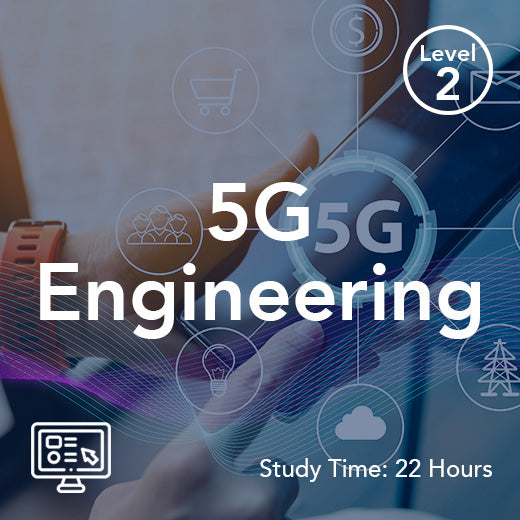
5G Engineering (On-Demand)
This 5G Engineering on-demand training course is designed to provide a comprehensive technical introduction to 5G technology. The course covers the design goals, development schedule, principles, design, and implementation of the 5G air interface, radio access network, and core network. Participants will gain a deep understanding of the operation of the 5G system through illustrated course books, videos, tests, and full tutor support. Engineers who are new to the field of mobile communications or those already working in the industry can benefit greatly from this course. Familiarity with telecommunications and general engineering terminology is assumed, and some understanding of LTE cellular systems would be beneficial for participants looking to get the most out of this training. By enrolling in this course, participants will delve into key topics such as 5G introduction, use cases, air interface principles, radio access network architecture, core network protocols, network function virtualisation, interworking between 5G, LTE, and Wi-Fi, and much more. With a total duration of 22 hours, this on-demand training course offers a flexible and convenient way to enhance your knowledge and skills in the rapidly evolving field of 5G technology. Who would benefit This course is intended for engineers either new to, or already working in, mobile communications. Prerequisites Familiarity with telecommunications and general engineering terminology is assumed. Some understanding of LTE cellular systems would be beneficial. Topic Areas Include 5G introduction, key features and standardisation Use cases and performance objectives Principles of the air interface: radio spectrum, OFDMA and multiple antennas Air interface protocol stack Architecture of the air interface physical layer Procedures for data transmission and reception on the 5G air interface Radio access network architecture and protocols Non-standalone and standalone deployment options Core network architecture and protocols Network function virtualisation and network slicing Interworking and compatibility between 5G, LTE and Wi-Fi PDU connectivity, Quality of Service and service provision Signalling procedures in the 5G network
£1,815.00
-
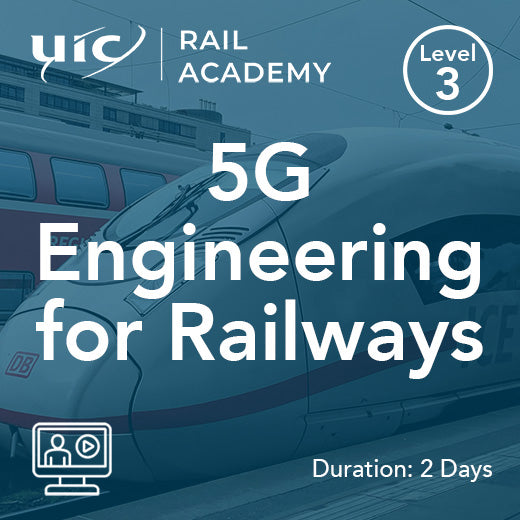
5G Engineering for Railways
This 5G Engineering for Railways course is a technical introduction to 5G. The course includes the design goals and development schedule for 5G, the principles, design and implementation of the 5G air interface, radio access network and core network, and the operation of the 5G system. With the emergence of FRMCS our 5G Rail portfolio addresses the technical requirements of FRMCS. Who would benefit This course is intended for engineers either new to, or already working in, mobile communications. Prerequisites Familiarity with telecommunications and general engineering terminology is assumed. Some understanding of LTE cellular systems would be beneficial. Topic Areas Include 5G introduction, key features and standardisation Use cases and performance objectives Principles of the air interface: radio spectrum, OFDMA and multiple antennas Air interface protocol stack Architecture of the air interface physical layer Procedures for data transmission and reception on the 5G air interface Radio access network architecture and protocols Non-standalone and standalone deployment options Core network architecture and protocols Network function virtualisation and network slicing Interworking and compatibility between 5G, LTE and Wi-Fi PDU connectivity, Quality of Service and service provision Signalling procedures in the 5G network
POA: Private Course
-
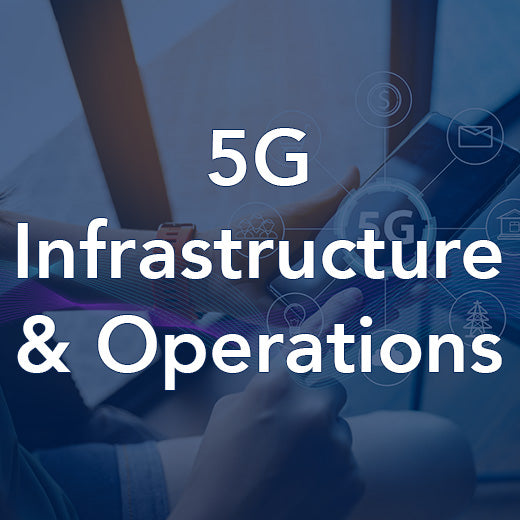
5G Infrastructure and Operation
Our 3-day 5G Infrastructure and Operation Training Course is designed for engineers new to or already working in mobile communications. This course covers essential topics such as Introduction to 5G, Principles of the 5G New Radio, 5G Air Interface, Radio Access Network Architecture, Core Network Architecture, Data Transport, 5G Protocols, 5G Procedures, and Releases 16 and 17. Our expert trainers will provide practical insights and real-world examples to enhance learning and ensure participants are well-equipped to navigate the complexities of 5G networks. For those looking to further enhance their skills, we also offer an optional 5G Virtual Lab Module where participants can explore, test, optimize, and troubleshoot the 5G system in a fully emulated environment. Prerequisites This course is intended for engineers either new to, or already working in, mobile communications. Course Contents Introduction to 5G Principles of the 5G New Radio 5G Air Interface Radio Access Network Architecture Core Network Architecture Data Transport 5G Protocols 5G Procedures Releases 16 and 17 Optional 5G Virtual Lab Module Explore, Test, Optimise, and Troubleshoot the 5G System Deep dive into the key signalling scenarios in the 5G system and analyse the output to build a deeper understanding that goes beyond the theoretical. The lab is a fully emulated 5G System environment that enables you to experiment with the configurations for Network Functions and build customized settings for signalling scenarios that helps you to develop greater insight into the operation of the 5G System. Lab modules can be added to any relevant 5G course. Learn more and arrange a demo.
POA: Private Course
-
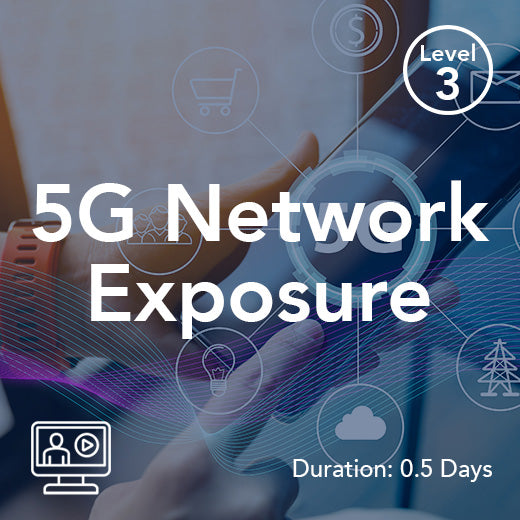
5G Network Exposure
This course is intended for engineers working on the 5G core network, who wish to learn about the exposure of core network capabilities to a third-party application server by way of the NEF. The course introduces the functionality of the NEF up to 3GPP Release 17, and provides an in-depth description of some of its more commonly used services. In the ever-evolving world of telecommunications, engineers working on the 5G core network must stay up-to-date with the latest advancements. Our 5G Network Exposure coursesis designed for engineers who want to understand how core network capabilities are exposed to third-party application servers through the Network Exposure Function (NEF). This course covers the functionality of the NEF up to 3GPP Release 17 and provides a detailed explanation of its commonly used services. To get the most out of this course, participants should have a basic understanding of the architecture and signalling protocols in the 5G core network. The session will delve into topics such as Network Exposure in 5G and Network Exposure Function Services, giving attendees a comprehensive overview of how these elements work together in the 5G ecosystem. For those looking to further enhance their learning experience, an optional 5G Virtual Lab Module is available for exploring, testing, optimizing, and troubleshooting the 5G system in a simulated environment. Stay ahead of the curve and deepen your knowledge of 5G network exposure with our interactive and informative online session. Join us to gain valuable insights and practical skills that will help you excel in your role as a 5G core network engineer. Prerequisites The course assumes a basic understanding of the architecture and signalling protocols in the 5G core network. Course Contents Network Exposure in 5G Network Exposure Function Services Optional 5G Virtual Lab Module Explore, Test, Optimise, and Troubleshoot the 5G System Deep dive into the key signalling scenarios in the 5G system and analyse the output to build a deeper understanding that goes beyond the theoretical. The lab is a fully emulated 5G System environment that enables you to experiment with the configurations for Network Functions and build customized settings for signalling scenarios that helps you to develop greater insight into the operation of the 5G System. Lab modules can be added to any relevant 5G course. Learn more and arrange a demo.
POA: Private Course
-
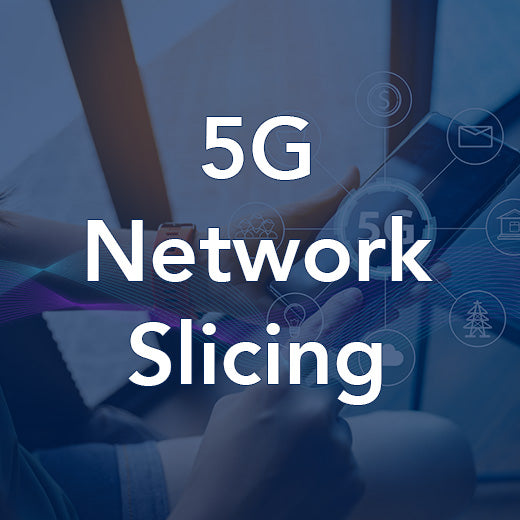
5G Network Slicing
This 5G Network Slicing course examines 5G network slicing and those topics that impact and drive slice strategy. Service and Industry requirements are explored, as well as use case performance objectives. Technical aspects of 5G slice operation are followed by an appraisal of the techniques available to map the requirements onto a practical slice. A generic slice template, and associated attributes, are then used to generate an example slice specification. Finally, practical slice deployment and management options are investigated. Examples are used throughout. Note – Although standard slice identities have been specified, slicing defines a set of techniques that enable operators to differentiate their service offerings. Hence, any “standard” slice templates should be considered as a proprietary solution. This course does NOT attempt to build or provide any such standard slice templates, but will enable participants to better assess slice strategy and evaluate specific solutions. This 5G Network Slicing training course delves into the complexities of 5G network slicing and the various factors that influence slice strategy. From exploring service and industry requirements to understanding use case performance objectives, participants will gain a comprehensive overview of the technical aspects of 5G slice operation. The course also covers techniques for mapping requirements onto practical slices, creating example slice specifications using a generic template, and exploring deployment and management options. Throughout the course, real-life examples are used to enhance understanding and application. Designed for professionals involved in the design, deployment, and commercialization of 5G networks, this course offers valuable insights into the intricacies of network slicing. While the course begins with an introduction to 5G and use case requirements, it primarily focuses on the technical aspects of network slicing. Prior experience or knowledge of the 5G system from a technical perspective would be beneficial for participants looking to maximize their learning outcomes. By the end of the course, participants will be equipped with the knowledge and skills needed to assess slice strategy and evaluate specific solutions effectively. Topics covered in this training course include an introduction to 5G, use cases, and connectivity, an in-depth exploration of 5G slicing, and practical guidance on slice development and deployment. Participants will gain a solid understanding of network slicing principles and techniques, enabling them to make informed decisions and contribute effectively to the successful implementation of 5G networks. Who would benefit This course is designed for those involved in the design, deployment and commercialisation of 5G. Prerequisites Although we begin with an introduction to 5G and use case requirements, the course focuses on the technical aspects of network slicing, so some experience or knowledge of the 5G system from a technical perspective would be an advantage. Topic Areas Include Introduction to 5G, Use Cases and Connectivity 5G Slicing Slice Development and Deployment Optional 5G Virtual Lab Module Explore, Test, Optimise, and Troubleshoot the 5G System Deep dive into the key signalling scenarios in the 5G system and analyse the output to build a deeper understanding that goes beyond the theoretical. The lab is a fully emulated 5G System environment that enables you to experiment with the configurations for Network Functions and build customized settings for signalling scenarios that helps you to develop greater insight into the operation of the 5G System. Lab modules can be added to any relevant 5G course. Learn more and arrange a demo.
POA: Private Course
-
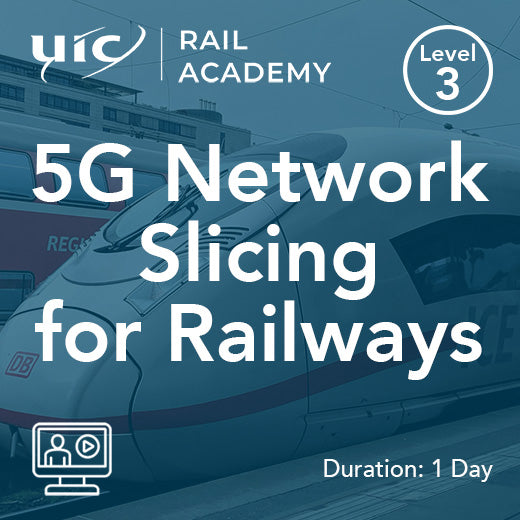
5G Network Slicing for Railways
This 5G Network Slicing for Railways course examines 5G network slicing and those topics that impact and drive slice strategy. Service and Industry requirements are explored, as well as use case performance objectives. Technical aspects of 5G slice operation are followed by an appraisal of the techniques available to map the requirements onto a practical slice. A generic slice template, and associated attributes, are then used to generate an example slice specification. Finally, practical slice deployment and management options are investigated. Examples are used throughout. With the emergence of FRMCS our 5G Rail portfolio addresses the technical requirements of FRMCS. Who would benefit This course is designed for those involved in the design, deployment and commercialisation of 5G. Prerequisites Although we begin with an introduction to 5G and use case requirements, the course focuses on the technical aspects of network slicing, so some experience or knowledge of the 5G system from a technical perspective would be an advantage. Topic Areas Include Introduction to 5G, Use Cases and Connectivity 5G Slicing Slice Development and Deployment Optional 5G Virtual Lab Module Explore, Test, Optimise, and Troubleshoot the 5G System Deep dive into the key signalling scenarios in the 5G system and analyse the output to build a deeper understanding that goes beyond the theoretical. The lab is a fully emulated 5G System environment that enables you to experiment with the configurations for Network Functions and build customized settings for signalling scenarios that helps you to develop greater insight into the operation of the 5G System. Lab modules can be added to any relevant 5G course. Learn more and arrange a demo.
POA: Private Course
-
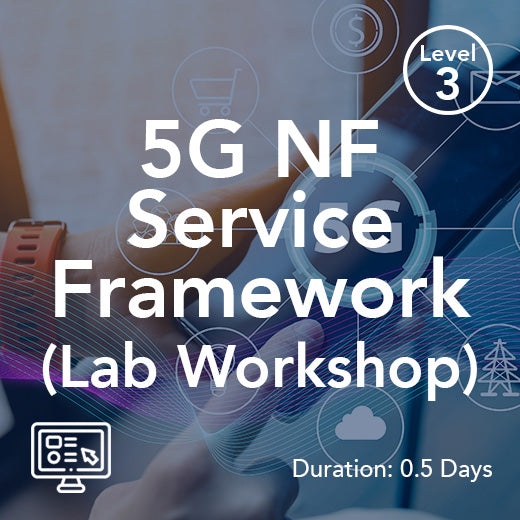
5G NF Service Framework (Lab Workshop)
Develop a deep understanding of the 5G NF Service Framework and analyse the intricacies of 5G Service Based Architecture (SBA) procedures The cloud-based lab provides participants with access to a fully emulated 5G System environment. Experiment with the configurations for various Network Functions within the 5G Core Network and build customized settings for signalling scenarios that will enable users to develop greater insight in to the operation of the 5G System. NF Service Framework Explore the intricacies of SBA procedures, this lab focuses on the procedures used in: SBA for Registration, Discovery, and Service Operations Examining HTTPv2 messages, including JSON-format content Lab Features & Benefits Through a combination of hands-on experience and guided instruction our virtual labs allow users to explore signalling procedures in the 5G system. Our labs feature: A simulated 5G network - Provides hands-on experience and reinforces theoretical knowledge. Guided exercises for signalling scenarios - makes learning and applying new concepts straightforward. Wireshark (pcap) output files – detailed output files provide deep system insight. Cloud-based lab - available 24/7 on any connected device. Individual dedicate server - Ensures that your work is kept private and secure. Ongoing trainer support - ensures you get expert advice when needed. Full integration with Wray Castles training programmes - allows you to build bespoke learning pathways for specialist teams across your organisation. You can find more information on our labs and arranges a demo here.
POA: Private Course
-
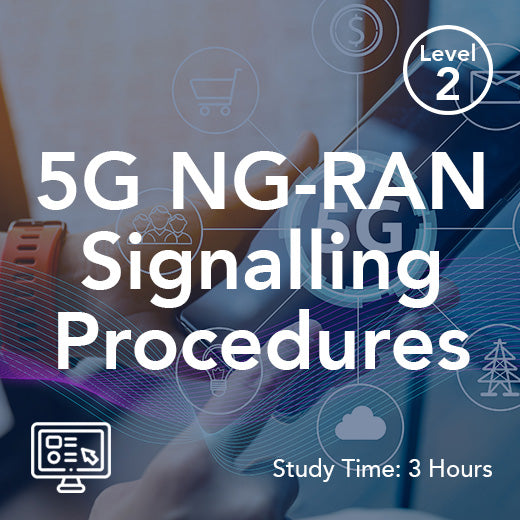
5G NG-RAN Signalling Procedures (On-Demand)
Mobility and state management are at the heart of delivering seamless connectivity in 5G networks. This short, single-module course provides a technical overview of how the 5G Next Generation Radio Access Network (NG-RAN) manages UE mobility and RRC state transitions through signalling interactions. In just three hours, you'll explore how devices move between key RRC states - RRC_IDLE, RRC_INACTIVE, and RRC_CONNECTED - and how signalling flows coordinate these transitions between the UE, gNBs, and core network functions such as the AMF, SMF, and UPF. The course covers a range of mobility procedures, including intra- and inter-gNB handovers, with a focus on signalling, context management, and data forwarding. You'll also learn how dual connectivity is managed, including the addition and release of secondary nodes. Designed for technical professionals who need a solid introduction to how 5G NG-RAN handles mobility and signalling, this course equips you with the essential knowledge required to understand and troubleshoot mobility-related behaviour in live 5G networks. Course Contents Idle Mode RRC Connected Mode RRC Inactive Mode RRC Connected Additional Handovers Secondary Nodes Final Transitions
£95.00
-
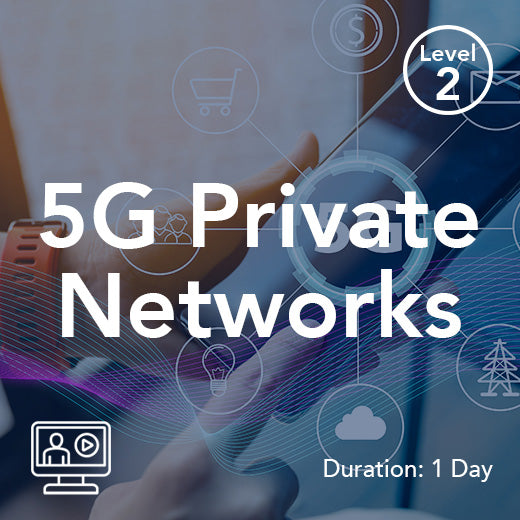
5G Private Networks
5G private networks have emerged as a transformative technology enabling businesses to unlock new levels of efficiency, productivity, and innovation. This course provides participants with a good understanding of the principles, technologies, and best practices involved in implementing private 5G networks.Participants will explore the specific characteristics and advantages of private networks, including dedicated spectrum, enhanced security, and network slicing capabilities. They will gain practical insights into the planning and design of private 5G networks, covering topics that include the radio aspects, network architecture, and integration with existing infrastructure. They will also learn about the deployment considerations unique to different industry verticals, such as manufacturing, logistics, healthcare, and public safety. Real-world case studies are included to enhance the learning experience and enable participants to apply their knowledge effectively in diverse industry contexts. Who Would Benefit The course is intended for network architects and engineers who are involved with the design, optimization, management, monitoring or testing of Private Networks. Prerequisites An engineering background with knowledge of core and radio access network technologies is assumed. A good understanding and experience of 5G and LTE networks would be desirable. Course Contents Introduction to Private Cellular Networks Private Network Use-Cases and Verticals The Benefits of 5G Technology for Enterprise Challenges Spectrum Access and Mobility Control Management and Security Multi-Access Edge Compute (MEC)
£980.00
-
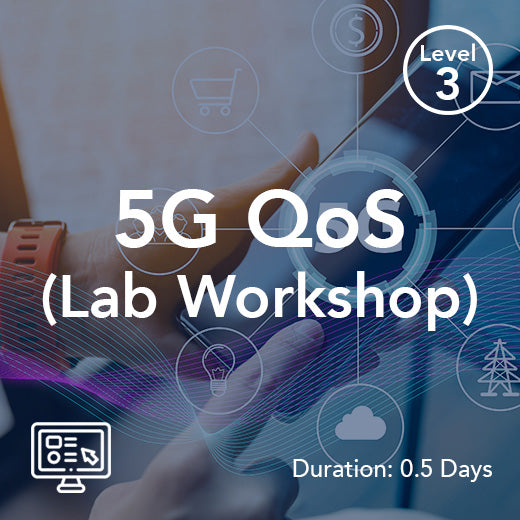
5G QoS (Lab Workshop)
Examine details of AM Policy and SM Policy associations created during registration and PDU Session Establishment with our 1/2-Day Virtual Lab. The cloud-based lab provides participants with access to a fully emulated 5G System environment. Experiment with the configurations for various Network Functions within the 5G Core Network and build customized settings for signalling scenarios that will enable users to develop greater insight in to the operation of the 5G System. 5G QoS Explore details of AM Policy and SM Policy associations created during registration and PDU Session Establishment 5G QoS model and details of QoS profile(s) and QoS rule(s) PCF and PCC rule(s) details Walk through of QoS parameters handling in 5G (5QI, ARP, MFBR, GFBR and AMBR) Lab Features & Benefits Through a combination of hands-on experience and guided instruction our virtual labs allow users to explore signalling procedures in the 5G system. Our labs feature: A simulated 5G network - Provides hands-on experience and reinforces theoretical knowledge. Guided exercises for signalling scenarios - makes learning and applying new concepts straightforward. Wireshark (pcap) output files – detailed output files provide deep system insight. Cloud-based lab - available 24/7 on any connected device. Individual dedicate server - Ensures that your work is kept private and secure. Ongoing trainer support - ensures you get expert advice when needed. Full integration with Wray Castles training programmes - allows you to build bespoke learning pathways for specialist teams across your organisation. You can find more information on our labs and arranges a demo here.
POA: Private Course
-
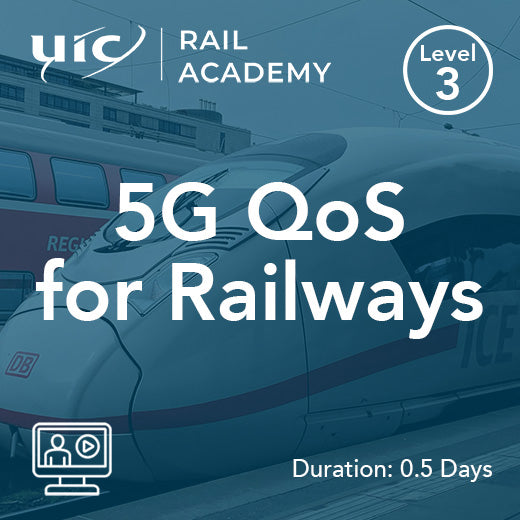
5G QoS for Railways
5G QoS for Railways is designed for those involved in the QoS and charging management and operations in 5G Standalone Networks Prerequisites The focus of this course is only on the PCC framework as specified by 3GPP thus participants should be familiar with 5G operations and general features prior to attending this training. Course Contents 5G PCC Framework Architecture 5G QoS Model Access and Mobility Association Session Management Policy Association AF Influence on Policy Decisions PCF Selection PCC Rules and PCC Rule handling
POA: Private Course
-
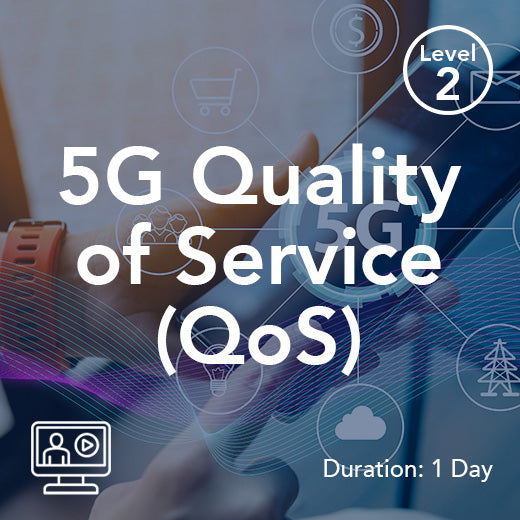
5G Quality of Service (QoS)
This course is designed for those involved in the QoS and charging management and operations in 5G Standalone Networks Prerequisites The focus of this course is only on the PCC framework as specified by 3GPP thus participants should be familiar with 5G operations and general features prior to attending this training. Course Contents 5G PCC Framework Architecture 5G QoS Model Access and Mobility Association Session Management Policy Association AF Influence on Policy Decisions PCF Selection PCC Rules and PCC Rule handling
POA: Private Course
-
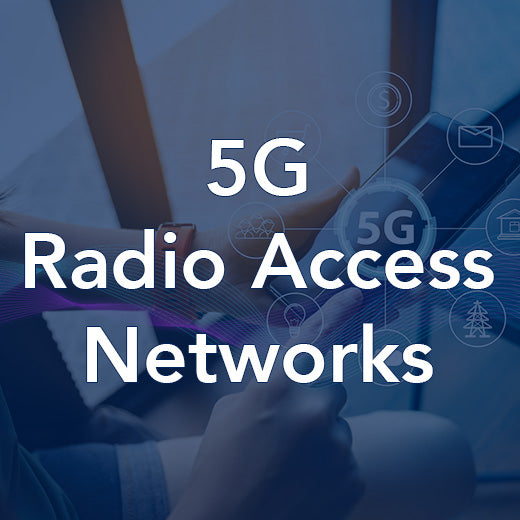
5G Radio Access Network
The 5G Radio Access Network on-demand course begins by discussing the key features of a 5G network before delving into the finer detail of the 5G New Radio. The 5G RAN is described in terms of network architecture, base station characteristics, spectrum usage and multiple antenna configurations. The transport of signalling and traffic over the 5G RAN interfaces, fronthaul and backhaul are analysed followed by an in depth study of the signalling protocols used over those interfaces. Our 5G Radio Access Network training course is designed to provide professionals in the telecommunications industry with the knowledge and skills needed to effectively design, deploy, and manage 5G networks. In this course, participants will learn about the key concepts and technologies behind 5G RAN, including massive MIMO, beamforming, and network slicing. By enrolling in our 5G RAN training course, you will be equipped with the latest industry insights and best practices to stay ahead in the rapidly evolving telecommunications landscape. Whether you are a network engineer, system architect, or project manager, this course will provide you with the tools and expertise needed to drive successful 5G RAN deployments. Join us at Wray Castle and take your career to the next level with our comprehensive 5G Radio Access Network training course. Who Would Benefit Engineers that need to know about the 5G Radio Access Network in terms of its characteristics, architecture, interfaces and operation Pre-requisites Ideally attendees will have a mobile telecommunications or radio background gained from the study of or working with GSM, UMTS or LTE networks. Topic Areas Include Introduction to 5G 5G RAN NG Interface Messages and Procedures Xn Interface Messages and Procedures E1 Interface Messages and Procedures F1 Interface Messages and Procedures Multi-RAT Dual Cennectivity Optional 5G Virtual Lab Module Explore, Test, Optimise, and Troubleshoot the 5G System Deep dive into the key signalling scenarios in the 5G system and analyse the output to build a deeper understanding that goes beyond the theoretical. The lab is a fully emulated 5G System environment that enables you to experiment with the configurations for Network Functions and build customized settings for signalling scenarios that helps you to develop greater insight into the operation of the 5G System. Lab modules can be added to any relevant 5G course. Learn more and arrange a demo. Also available as a Self-Paced Online Training Programme, learn more.
POA: Private Course
-
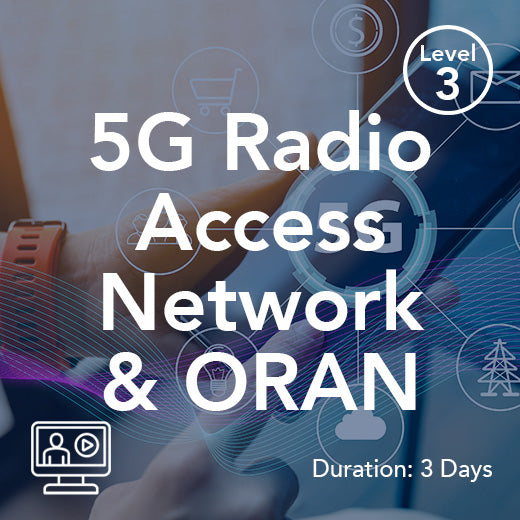
5G Radio Access Network & ORAN
This three-day course offers a comprehensive exploration of both 5G Radio Access Networks (RAN) and Open Radio Access Networks (ORAN). Participants will gain a deep understanding of the key features of a 5G network, including the 5G New Radio and the architecture, characteristics, and spectrum usage of the 5G RAN. The course also covers the transport of signalling and traffic over the 5G RAN interfaces, as well as an in-depth study of the signalling protocols used. In addition, participants will receive a solid introduction to Open RAN, learning about its purpose, features, architecture, operation, and deployment options. The course also explores how ORAN principles, rooted in virtualisation, support the evolution to 5G and the impact of using ORAN architecture on open and standardised interfaces. This course is ideal for those in or entering technical roles in a mobile network operator's Radio Access Network (RAN) environment. Overall, this course provides a comprehensive overview of 5G RAN and ORAN, equipping participants with the knowledge and skills needed to excel in technical roles within the mobile network industry. With a focus on both theoretical concepts and practical applications, participants will gain valuable insights into the latest developments in 5G technology and its impact on network architecture and operations. Who Would Benefit Those in or entering technical roles in a mobile network operators Radio Access Network (RAN) environment. Course Modules: Introduction to 5G The Next Generation Radio Access Network Signalling Protocols in the NG-RAN Signalling Procedures in the NG-RAN 5G Releases 16 to 18 Radio Access Networks ORAN Players 3GPP RAN Architecture for 5G O-RAN Architecture and Operation Whitebox Base Stations
£2,660.00
-
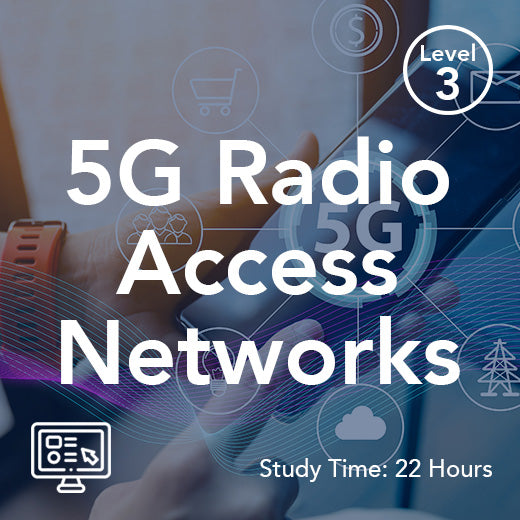
5G Radio Access Network (On-Demand)
Our 5G Radio Access Network training course is designed to provide professionals in the telecommunications industry with the knowledge and skills needed to effectively design, deploy, and manage 5G networks. In this course, participants will learn about the key concepts and technologies behind 5G RAN, including massive MIMO, beamforming, and network slicing. Our expert trainers will guide you through hands-on exercises and real-world case studies to help you gain practical experience in implementing 5G RAN solutions. By enrolling in our 5G RAN training course, you will be equipped with the latest industry insights and best practices to stay ahead in the rapidly evolving telecommunications landscape. Whether you are a network engineer, system architect, or project manager, this course will provide you with the tools and expertise needed to drive successful 5G RAN deployments. Join us at Wray Castle and take your career to the next level with our comprehensive 5G Radio Access Network training course. This self-paced on-demand distance learning course features illustrated course books, videos, tests and full tutor support. Who Would Benefit Engineers that need to know about the 5G Radio Access Network in terms of its characteristics, architecture, interfaces and operation Prerequisites Ideally students will have a mobile telecommunications or radio background gained from the study of or working with GSM, UMTS or LTE networks. Topic Areas Include Introduction to 5G 5G RAN NG Interface Messages and Procedures Xn Interface Messages and Procedures E1 Interface Messages and Procedures F1 Interface Messages and Procedures Multi-RAT Dual Cennectivity
£750.00
-
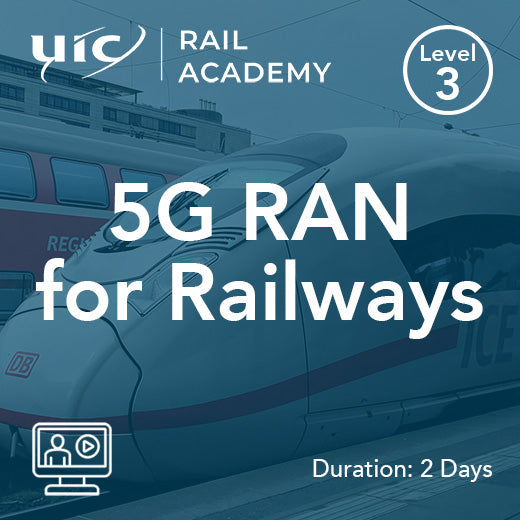
5G Radio Access Network for Railways
The 5G Radio Access Network for Railways course begins by discussing the key features of a 5G network before delving into the finer detail of the 5G New Radio. The 5G RAN is described in terms of network architecture, base station characteristics, spectrum usage and multiple antenna configurations. The transport of signalling and traffic over the 5G RAN interfaces, fronthaul and backhaul are analysed followed by an in depth study of the signalling protocols used over those interfaces. With the emergence of FRMCS our 5G Rail portfolio addresses the technical requirements of FRMCS. Who Would Benefit Engineers that need to know about the 5G Radio Access Network in terms of its characteristics, architecture, interfaces and operation Pre-requisites Ideally attendees will have a mobile telecommunications or radio background gained from the study of or working with GSM, UMTS or LTE networks. Topic Areas Include Introduction to 5G 5G RAN NG Interface Messages and Procedures Xn Interface Messages and Procedures E1 Interface Messages and Procedures F1 Interface Messages and Procedures Multi-RAT Dual Cennectivity Optional 5G Virtual Lab Module Explore, Test, Optimise, and Troubleshoot the 5G System Deep dive into the key signalling scenarios in the 5G system and analyse the output to build a deeper understanding that goes beyond the theoretical. The lab is a fully emulated 5G System environment that enables you to experiment with the configurations for Network Functions and build customized settings for signalling scenarios that helps you to develop greater insight into the operation of the 5G System. Lab modules can be added to any relevant 5G course. Learn more and arrange a demo.
POA: Private Course
-
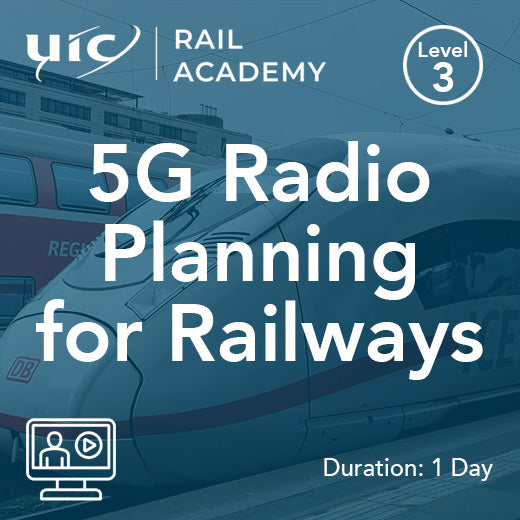
5G Radio Planning for Railways
The heart of any cell planning process begins with coverage and capacity estimations, this 5G Cell Planning for Railways training course will guide you through the variables that impact both coverage and capacity and provides practical worked examples for a variety of scenarios. As well as the planning process it is also important to understand the RF KPIs and measurements that determine link performance, the essential signals and measurement techniques of the NR are covered in this training as well as a detailed look at parameters that affect the random access process, location management and PCI planning. At the conclusion of this training the student will be well versed in the theory and practice of 5G cell planning with a good understanding of both the principles and application of planning techniques. With the emergence of FRMCS our 5G Rail portfolio addresses the technical requirements of FRMCS. Who Would Benefit This course is intended for network planning engineers working in the rail industry, who wish to learn about the issues that are involved when planning radio access networks for 5G FRMCS Prerequisites The course assumes familiarity with telecommunication systems and with the principles of radio network planning gained from planning GSM-R networks. Otherwise, experience gained in network planning for LTE, and knowledge of the 5G air interface, would be beneficial. Topic Areas Include Fundamentals of the 5G Air Interface Link Budget Estimation Coverage Estimation Capacity Estimation RSRP, RSRQ and SINR Parameter Setting
£1,815.00
-
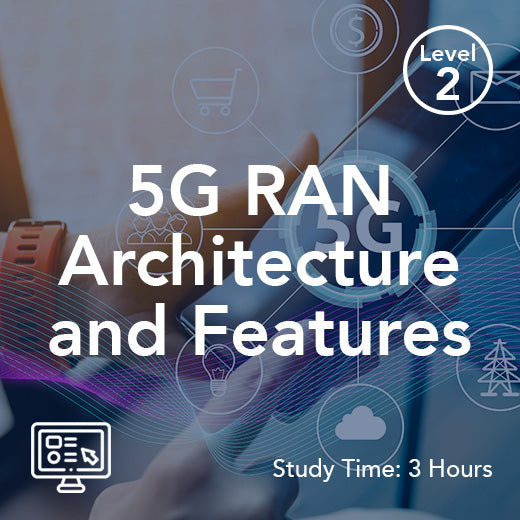
5G RAN Architecture and Features (On-Demand)
As 5G networks continue to expand and evolve, a solid understanding of the 5G Radio Access Network (RAN) is essential for those involved in mobile network planning, deployment, or operations. This short, single-module course provides a focused overview of the 5G RAN architecture and the key features that distinguish it from previous generations. In just three hours, you'll explore the structure of the 5G RAN, including the role of the gNB (Next Generation Node B) and its functional split into Centralised Units (CUs) and Distributed Units (DUs). The course explains the key interfaces - NG, Xn, F1, and E1 - that enable communication between RAN components, other base stations, and the core network. You'll also gain insight into different deployment scenarios such as Dual Connectivity (DC) and Multi-RAT Dual Connectivity (MR-DC), which allow 5G to coexist and coordinate with legacy networks. Additionally, the course covers the evolution of the fronthaul interface from CPRI to eCPRI, the importance of backhaul capacity, and the need for precise timing and synchronisation in high-performance 5G networks. Designed for technical professionals needing a clear and accessible introduction to 5G RAN architecture, this course delivers the essential concepts required to understand and engage with today’s 5G radio access technologies. Course Contents 5G RAN Overview Dual Connectivity (DC) 5G non-Standalone and Standalone Options RAN Options EN-DC NGEN-DC and NE-DC RAN User Plane Connectivity RAN Control Plane Connectivity gNB Architecture Centralized and Distributed Deployments Common Public Radio Interface (CPRI) and eCPRI Fronthaul and Backhaul Requirements Synchronisation Requirements
£95.00
-
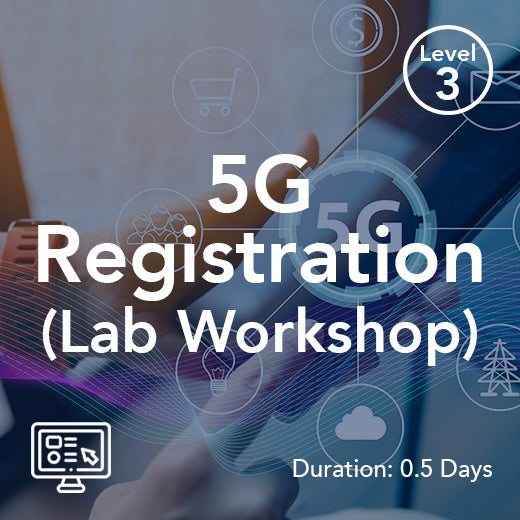
5G Registration (Lab Workshop)
Deep dive into the 5G Registration Message Flow, analyse the output (via Wireshark pcap files) and gain a comprehensive understanding of the 5G registration protocol. The cloud-based lab provides participants with access to a fully emulated 5G System environment. Experiment with the configurations for various Network Functions within the 5G Core Network and build customized settings for signalling scenarios that will enable users to develop greater insight in to the operation of the 5G System. Registration Message Flow Gain a comprehensive understanding of the 5G registration protocols including: Message flows for 5G-AKA Subscriber Data Management PCF Interaction Signalling by NAS, NGAP, and HTTPv2 protocols. Lab Features & Benefits Through a combination of hands-on experience and guided instruction our virtual labs allow users to explore signalling procedures in the 5G system. Our labs feature: A simulated 5G network - Provides hands-on experience and reinforces theoretical knowledge. Guided exercises for signalling scenarios - makes learning and applying new concepts straightforward. Wireshark (pcap) output files – detailed output files provide deep system insight. Cloud-based lab - available 24/7 on any connected device. Individual dedicate server - Ensures that your work is kept private and secure. Ongoing trainer support - ensures you get expert advice when needed. Full integration with Wray Castles training programmes - allows you to build bespoke learning pathways for specialist teams across your organisation. You can find more information on our labs and arranges a demo here.
POA: Private Course
-
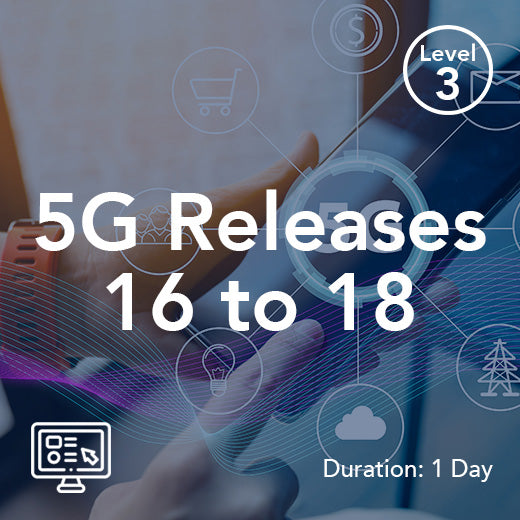
5G Releases 16 to 18
This 1/2-day course provides an overview of the latest advancements in 5G technology, specifically focusing on Releases 16, 17, and 18. Participants will gain insight into the enhanced capabilities of 5G and 5G-Advanced, covering topics such as Vehicle-to-Everything (V2X) services, Integrated Access and Backhaul (IAB), Non-Terrestrial Networks (NTNs), Machine Type Communications (MTC), and the Industrial Internet of Things (IIoT). This course is designed to keep engineers up-to-date with the evolving landscape of 5G technology. Engineers looking to expand their knowledge and understanding of 5G technology would greatly benefit from this course. It is ideal for individuals who are already familiar with mobile telecommunication systems and have a basic understanding of 5G Release 15. By completing this course, participants will be equipped with the necessary knowledge to navigate the complexities of 5G technology and stay ahead in this rapidly evolving industry. Who would benefit The course is intended for engineers who require an up-to-date knowledge of the capabilities of 5G. Prerequisites The course assumes familiarity with mobile telecommunication systems and a basic understanding of 5G Release 15.
POA: Private Course
-
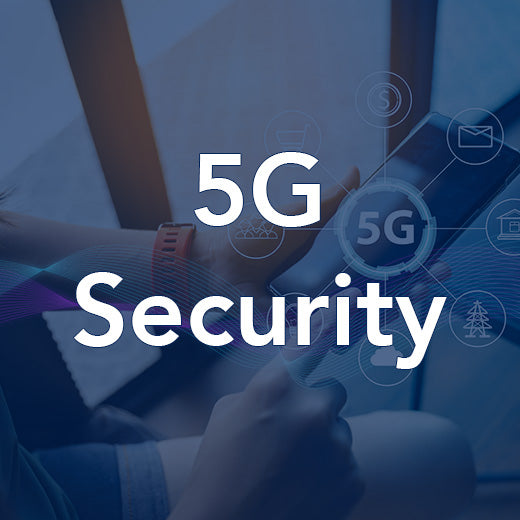
5G Security
The nature of 5G means that the security architecture and processes need to cover new aspects (when compared to previous 3GPP generations), including 5GNR/LTE Dual Connectivity, standardized interfaces for distributed gNB / RAN architectures, more tightly integrated Non-3GPP Access, and most significantly, the new Service Based Interfaces used within the 5G Core. The 5G Security course provides a comprehensive grounding in this expanded set of security requirements and mechanisms used in 5G. We start by considering the 5G architecture in order to better understand the overall security requirements for both the UE and network. We then build on the security architecture of 4G LTE, with relevant modifications and additions required for 5G, before focusing squarely on the additional features and procedures required to secure the 5G Core Network (Service Based Interface). Who would benefit This course is designed for engineers, managers and other personnel who have a need to acquire a technical overview of the security environment employed within 5G networks. It will also be of benefit to those in the wider technical community who have a need to understand the security protocols employed by advanced cellular networks. Prerequisites An understanding of 4G (and legacy 2G and 3G) security procedures would be an advantage as would a basic understanding of 5G and / or LTE network architecture and functionality. Topic Areas Include 5G Architecture and the Service Based Interface 5G Security Architecture and Authentication and Key Agreement Security and the Service Based Interface (including SEPP)
£980.00
-
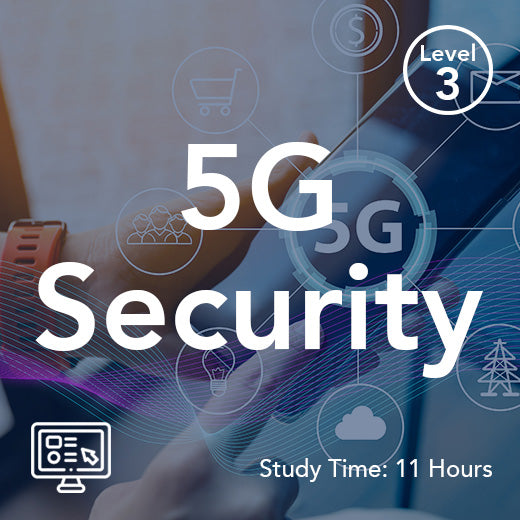
5G Security (On-Demand)
The nature of 5G means that the security architecture and processes need to cover new aspects (when compared to previous 3GPP generations), including 5GNR/LTE Dual Connectivity, standardized interfaces for distributed gNB / RAN architectures, more tightly integrated Non-3GPP Access, and most significantly, the new Service Based Interfaces used within the 5G Core. The 5G Security on-demand course provides a comprehensive grounding in this expanded set of security requirements and mechanisms used in 5G. We start by considering the 5G architecture in order to better understand the overall security requirements for both the UE and network. We then build on the security architecture of 4G LTE, with relevant modifications and additions required for 5G, before focusing squarely on the additional features and procedures required to secure the 5G Core Network (Service Based Interface). This self-paced on-demand distance learning course features illustrated course books, videos, tests and full tutor support. Who would benefit This course is designed for engineers, managers and other personnel who have a need to acquire a technical overview of the security environment employed within 5G networks. It will also be of benefit to those in the wider technical community who have a need to understand the security protocols employed by advanced cellular networks. Prerequisites An understanding of 4G (and legacy 2G and 3G) security procedures would be an advantage as would a basic understanding of 5G and / or LTE network architecture and functionality. Topic Areas Include 5G Architecture and the Service Based Interface 5G Security Architecture and Authentication and Key Agreement Security and the Service Based Interface (including SEPP)
£500.00
-
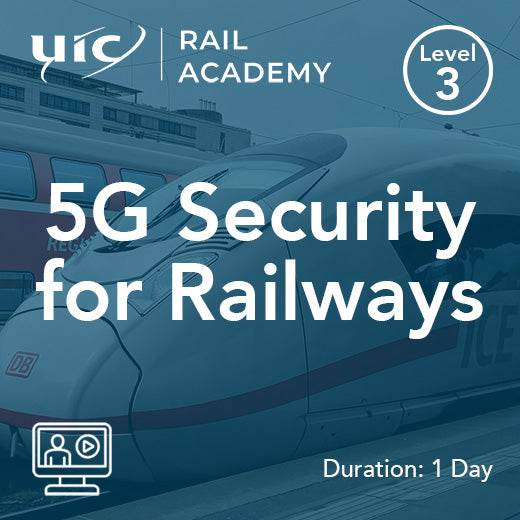
5G Security for Railways
The nature of 5G means that the security architecture and processes need to cover new aspects (when compared to previous 3GPP generations), including 5GNR/LTE Dual Connectivity, standardized interfaces for distributed gNB / RAN architectures, more tightly integrated Non-3GPP Access, and most significantly, the new Service Based Interfaces used within the 5G Core. The 5G Security for Railways course provides a comprehensive grounding in this expanded set of security requirements and mechanisms used in 5G. We start by considering the 5G architecture in order to better understand the overall security requirements for both the UE and network. We then build on the security architecture of 4G LTE, with relevant modifications and additions required for 5G, before focusing squarely on the additional features and procedures required to secure the 5G Core Network (Service Based Interface). With the emergence of FRMCS our 5G Rail portfolio addresses the technical requirements of FRMCS. Who would benefit This course is designed for engineers, managers and other personnel who have a need to acquire a technical overview of the security environment employed within 5G networks. It will also be of benefit to those in the wider technical community who have a need to understand the security protocols employed by advanced cellular networks. Prerequisites An understanding of 4G (and legacy 2G and 3G) security procedures would be an advantage as would a basic understanding of 5G and / or LTE network architecture and functionality. Topic Areas Include 5G Architecture and the Service Based Interface 5G Security Architecture and Authentication and Key Agreement Security and the Service Based Interface (including SEPP)
POA: Private Course
-
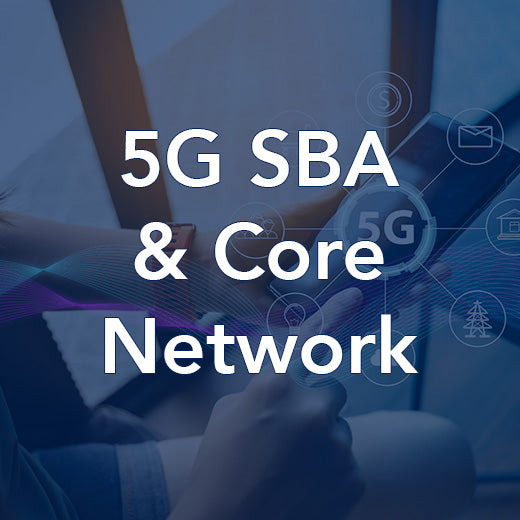
5G Service Based Architecture and Core Network
Our 5G Service Based Architecture and Core Network Training Course is designed to provide a comprehensive understanding of core network functions within the SBA, as well as the protocols and technologies that support the 5G Core. Through example procedures and in-depth exploration of the Service Based Interface (SBI) and Service APIs, participants will gain valuable insights into key 5G enabling principles such as virtualization and network slicing. Additionally, the course covers security on the SBI, introducing new network functions and techniques that enhance the security features of the core network domain. Ideal for professionals involved in the design, deployment, and development of 5G Service Based Architecture and the 5G Core, this technical course requires some prior knowledge or experience with the 5G system from a technical perspective. Topics covered include 5G introduction and deployment options, core network functions, supporting protocols and technologies, SBI security, and more. Participants will benefit from live online sessions led by industry experts, providing a dynamic and interactive learning experience. For those looking to explore, test, optimize, and troubleshoot the 5G system beyond the theoretical, we also offer an optional 5G Virtual Lab Module. This fully emulated environment allows participants to experiment with configurations for Network Functions and customize settings for signaling scenarios, providing a hands-on approach to developing a deeper understanding of the operation of the 5G system. Who would benefit This course is designed for those involved in the design, deployment and development of the 5G Service Based Architecture and the 5G Core. Prerequisites This is a technical course, so experience or knowledge of the 5G system from a technical perspective would be an advantage. Topic Areas Include 5G Introduction and Deployment Options The 5G Core Network Functions 5G Core Supporting Protocols and Technologies The Service Based Interface (SBI) and Service APIs Explained Procedures Deployment options SBI Security Optional 5G Virtual Lab Module Explore, Test, Optimise, and Troubleshoot the 5G System Deep dive into the key signalling scenarios in the 5G system and analyse the output to build a deeper understanding that goes beyond the theoretical. The lab is a fully emulated 5G System environment that enables you to experiment with the configurations for Network Functions and build customized settings for signalling scenarios that helps you to develop greater insight into the operation of the 5G System. Lab modules can be added to any relevant 5G course. Learn more and arrange a demo. Also available as a Self-Paced Online Training Programme, learn more.
POA: Private Course
-
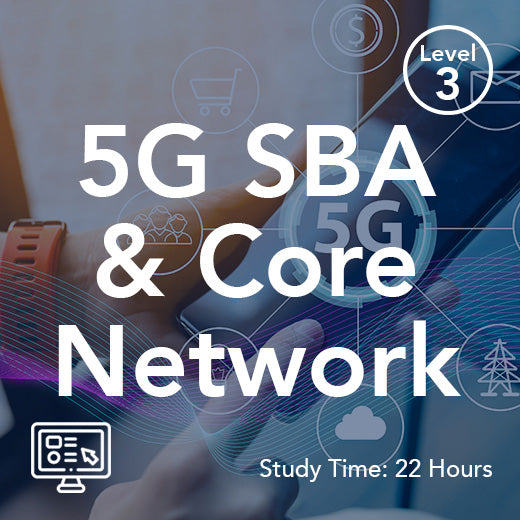
5G Service Based Architecture and Core Network (On-Demand)
Our 5G Service Based Architecture and Core Network Training Course is designed to provide a comprehensive understanding of core network functions within the SBA, as well as the protocols and technologies that support the 5G Core. Through example procedures and in-depth exploration of the Service Based Interface (SBI) and Service APIs, participants will gain valuable insights into key 5G enabling principles such as virtualization and network slicing. Additionally, the course covers security on the SBI, introducing new network functions and techniques that enhance the security features of the core network domain. Ideal for professionals involved in the design, deployment, and development of 5G Service Based Architecture and the 5G Core, this technical course requires some prior knowledge or experience with the 5G system from a technical perspective. Topics covered include 5G introduction and deployment options, core network functions, supporting protocols and technologies, SBI security, and more. Participants will benefit from live online sessions led by industry experts, providing a dynamic and interactive learning experience. For those looking to explore, test, optimize, and troubleshoot the 5G system beyond the theoretical, we also offer an optional 5G Virtual Lab Module. This fully emulated environment allows participants to experiment with configurations for Network Functions and customize settings for signaling scenarios, providing a hands-on approach to developing a deeper understanding of the operation of the 5G system. This self-paced on-demand distance learning course features illustrated course books, videos, tests and full tutor support. Who would benefit This course is designed for those involved in the design, deployment and development of the 5G Service Based Architecture and the 5G Core. Prerequisites This is a technical course, so experience or knowledge of the 5G system from a technical perspective would be an advantage. Topic Areas Include 5G Introduction and Deployment Options The 5G Core Network Functions 5G Core Supporting Protocols and Technologies The Service Based Interface (SBI) and Service APIs Explained Procedures Deployment options SBI Security
£750.00
-
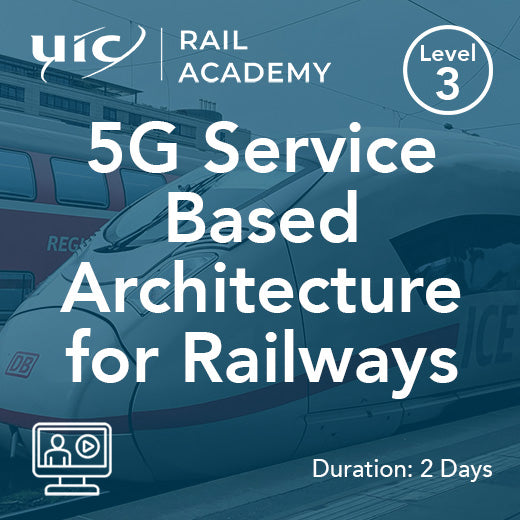
5G Service Based Architecture for Railways
5G Service Based Architecture for Railways training course expores the Core Network Functions , including their overall purpose, their specific role within the SBA, and the features / services that they support. This is followed by a comprehensive survey of the 5G Core and SBA supporting protocols and technologies, as well as a thorough examination of the Service Based Interface (SBI) and Service APIs (Application Programming Interfaces). Example procedures then allow us to build a comprehensive picture of the relevant techniques and features, and to make sense of the way in which the SBA is consistent with, and supports, key 5G enabling principles - including virtualisation and network slicing. Finally, security on the SBI is explored, highlighting the new network functions and techniques that have been introduced with 5G to provide new security features (including the roaming scenario), and a more secure core network domain. With the emergence of FRMCS our 5G Rail portfolio addresses the technical requirements of FRMCS. Who would benefit This course is designed for those involved in the design, deployment and development of the 5G Service Based Architecture and the 5G Core. Prerequisites This is a technical course, so experience or knowledge of the 5G system from a technical perspective would be an advantage. Topic Areas Include 5G Introduction and Deployment Options The 5G Core Network Functions 5G Core Supporting Protocols and Technologies The Service Based Interface (SBI) and Service APIs Explained Procedures Deployment options SBI Security Optional 5G Virtual Lab Module Explore, Test, Optimise, and Troubleshoot the 5G System Deep dive into the key signalling scenarios in the 5G system and analyse the output to build a deeper understanding that goes beyond the theoretical. The lab is a fully emulated 5G System environment that enables you to experiment with the configurations for Network Functions and build customized settings for signalling scenarios that helps you to develop greater insight into the operation of the 5G System. Lab modules can be added to any relevant 5G course. Learn more and arrange a demo.
POA: Private Course
-
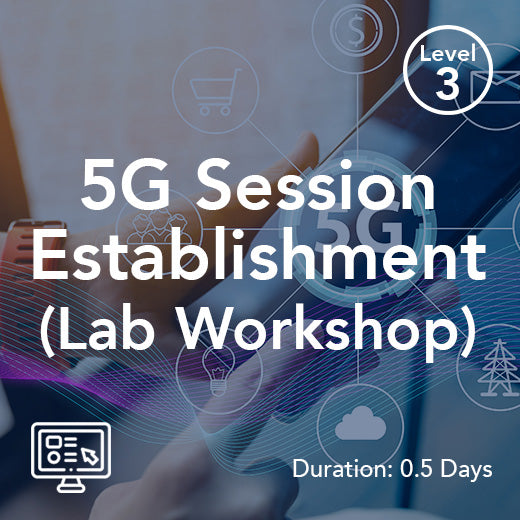
5G Session Establishment (Lab Workshop)
Deep dive into the 5G Session Establishment Procedure and User Plane Resource setup, analyse the output (via Wireshark pcap files) and gain a comprehensive understanding of the 5G Session Establishment Procedure. The cloud-based lab provides participants with access to a fully emulated 5G System environment. Experiment with the configurations for various Network Functions within the 5G Core Network and build customized settings for signalling scenarios that will enable users to develop greater insight in to the operation of the 5G System. Session Establishment Message Flow Get hands-on experience of Session Establishment Procedure and User Plane Resource setup including: PFCP Signalling towards the UPF, using PFCP protocol 5GSM signalling details Lab Features & Benefits Through a combination of hands-on experience and guided instruction our virtual labs allow users to explore signalling procedures in the 5G system. Our labs feature: A simulated 5G network - Provides hands-on experience and reinforces theoretical knowledge. Guided exercises for signalling scenarios - makes learning and applying new concepts straightforward. Wireshark (pcap) output files – detailed output files provide deep system insight. Cloud-based lab - available 24/7 on any connected device. Individual dedicate server - Ensures that your work is kept private and secure. Ongoing trainer support - ensures you get expert advice when needed. Full integration with Wray Castles training programmes - allows you to build bespoke learning pathways for specialist teams across your organisation. You can find more information on our labs and arranges a demo here.
POA: Private Course
-
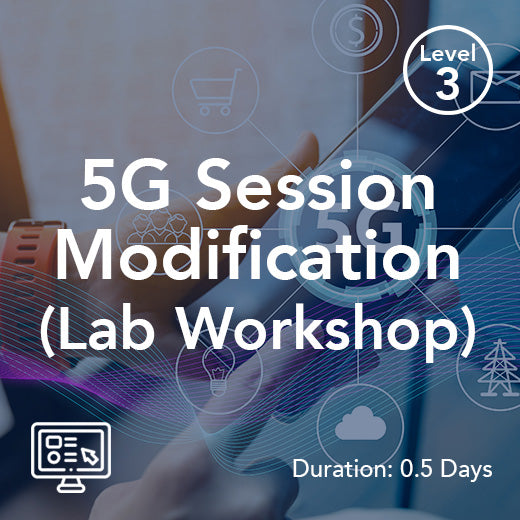
5G Session Modification (Lab Workshop)
This 1/2-day lab enables you to develop a deep understanding of the 5G Session Modification Message Flow insights into the intricacies of the modification process The cloud-based labs provides participants with access to a fully emulated 5G System environment. Experiment with the configurations for various Network Functions within the 5G Core Network and build customized settings for signalling scenarios that will enable users to develop greater insight in to the operation of the 5G System. Session Modification Message Flow Develop insights into the intricacies of the modification process, this lab examines: Modifying an existing PDU Session for SSC Modes 2 and 3 Addition and deletion of UPF for User Plane resources UL CL and PFCP message flow Lab Features & Benefits Through a combination of hands-on experience and guided instruction our virtual labs allow users to explore signalling procedures in the 5G system. Our labs feature: A simulated 5G network - Provides hands-on experience and reinforces theoretical knowledge. Guided exercises for signalling scenarios - makes learning and applying new concepts straightforward. Wireshark (pcap) output files – detailed output files provide deep system insight. Cloud-based lab - available 24/7 on any connected device. Individual dedicate server - Ensures that your work is kept private and secure. Ongoing trainer support - ensures you get expert advice when needed. Full integration with Wray Castles training programmes - allows you to build bespoke learning pathways for specialist teams across your organisation. You can find more information on our labs and arranges a demo here.
POA: Private Course
-
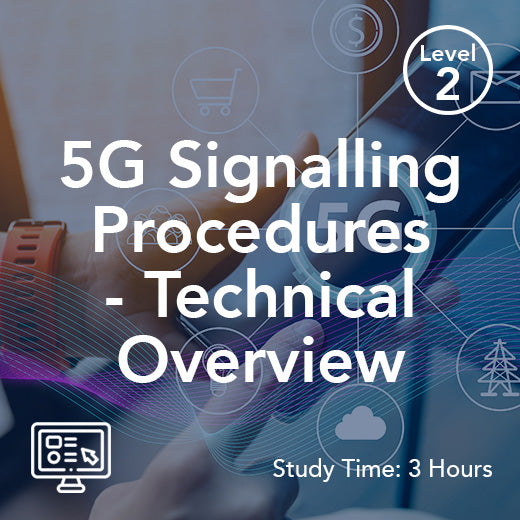
5G Signalling Procedures - Technical Overview (On-Demand)
As 5G networks mature, a solid grasp of the procedures that govern how devices and network functions interact is essential for professionals working in planning, operations, or optimisation. This short course offers a technical overview of the core signalling and operational procedures in 5G Standalone (SA) networks. In just three hours, you'll explore how 5G procedures have evolved - from initial deployments that relied on LTE signalling to fully native 5G implementations across both the core and radio access network. The course covers the step-by-step processes involved in device registration, network function discovery, and session establishment and modification. You'll also gain insight into mobility management procedures, including how 5G handles transitions between different UE states - idle, connected, and inactive - and how it manages tasks like cell selection, registration updates, service requests, and handovers. The role of the Radio Resource Control (RRC) protocol in managing radio connections, reporting measurements, and supporting dual connectivity scenarios is also explained. This course is designed to provide technical professionals with a foundational understanding of how 5G devices and networks interact through signalling and procedure flows, forming the basis for reliable service delivery in real-world deployments. Course Contents 5G Procedures NF Service Registration, Discovery, Subscription and Notification Power-on Procedures Registration Procedure PDU Session Establishment Server-triggered PDU Session Modification and QoS Flow Establishment Change of PDU Session Anchor Mobility Management and Registration Update UE Triggered Service Request Procedure RNA Update and RRC Transitions Xn-based Handover Procedure Addition of a Secondary Node Access Network Release Procedure Signalling Procedures RRC Signalling Overview NSA and SA RRC Reconfiguration Message Overview RRC Measurements Procedures MR-DC Procedures
£95.00
-
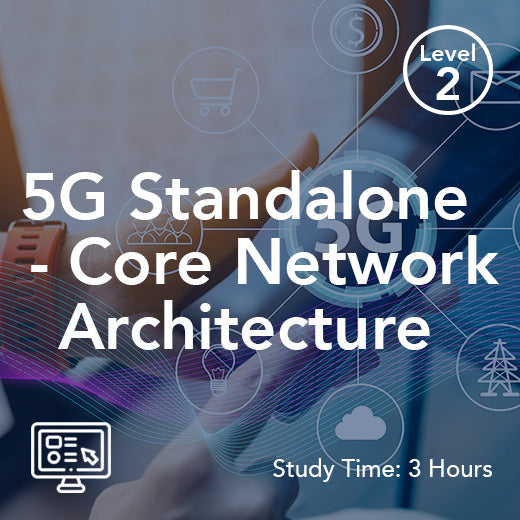
5G Standalone - Core Network Architecture (On-Demand)
As mobile networks transition to full 5G Standalone deployments, understanding the 5G Core (5GC) is essential for engineers and technical professionals involved in network design, deployment, or support. This single-module course offers a concise but comprehensive introduction to the 5G Core Network Architecture. In just three hours, you’ll explore the key building blocks of the 5G Core, including the main network functions such as the UDM, AMF, SMF, and UPF, and their roles in managing subscriber data, mobility, sessions, and user traffic. The module also explains important network and UE identifiers, tracking area concepts, and the role of service-based interfaces in enabling 5G’s flexibility. You’ll gain insight into how 5G supports roaming, interworks with legacy EPC networks, and introduces network slicing—a powerful concept that allows the same physical network to support a wide variety of use cases with different performance requirements. This course is ideal for those who need a technical overview of the 5G Core without going deep into protocol-level detail, and serves as a foundation for further learning or practical application in 5G projects. Course Contents 5G Core Network Functions Overview Reference Point Architecture 5G Roaming Architectures Service Based Architecture Service Based Interface Concepts 5G Core Network Functions Data Storage Architecture Interworking and Migration Non-3GPP Access 5G Identities Identities for Network Slicing TAC and RAN Identites
£95.00
-
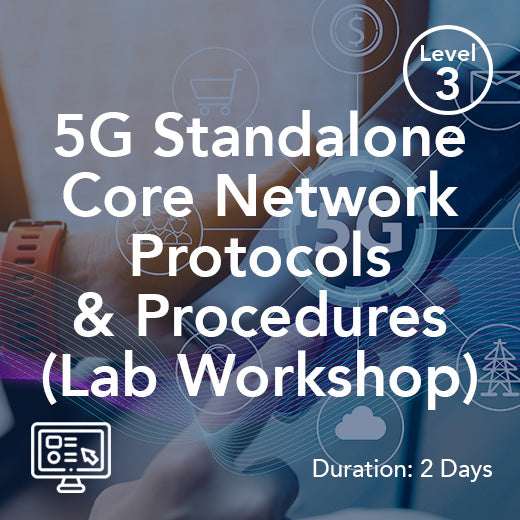
5G Standalone - Core Network Protocols and Procedures (Lab Workshop)
Deep dive into 5G Standalone Core Network Protocols and Procedures with this lab workshop. The lab workshop includes a mix of theory and hands-on exercises and includes a detailed guide covering exercises on various protocols and signalling scenarios in 5G System. The focus of the lab is the 5G Core Network with extensive coverage of the Service Based Architecture and HTTPv2 including JSON. Furthermore all protocols around the 5G Core Network are examined (PFCP, NGAP and 5G NAS). The cloud-based lab provides participants with access to a fully emulated 5G System environment. Experiment with the configurations for various Network Functions within the 5G Core Network and build customized settings for signalling scenarios that will enable users to develop greater insight in to the operation of the 5G System. Topic Areas Include: Protocols: 5G NAS: 5GMM & 5GSM NGAP SBA and HTTPv2 JSON PFCP GTP-u Signalling Procedures: Registration Deregistration PDU Session GUTI Registration Service Request Paging Xn Handover N2 Handover UL CL – Uplink Classifier Lab Features & Benefits Through a combination of hands-on experience and guided instruction our virtual labs allow users to explore signalling procedures in the 5G system. Our labs feature: A simulated 5G network - Provides hands-on experience and reinforces theoretical knowledge. Guided exercises for signalling scenarios - makes learning and applying new concepts straightforward. Wireshark (pcap) output files – detailed output files provide deep system insight. Cloud-based lab - available 24/7 on any connected device. Individual dedicate server - Ensures that your work is kept private and secure. Ongoing trainer support - ensures you get expert advice when needed. Full integration with Wray Castles training programmes - allows you to build bespoke learning pathways for specialist teams across your organisation. You can find more information on our labs and arranges a demo here.
£1,815.00
-
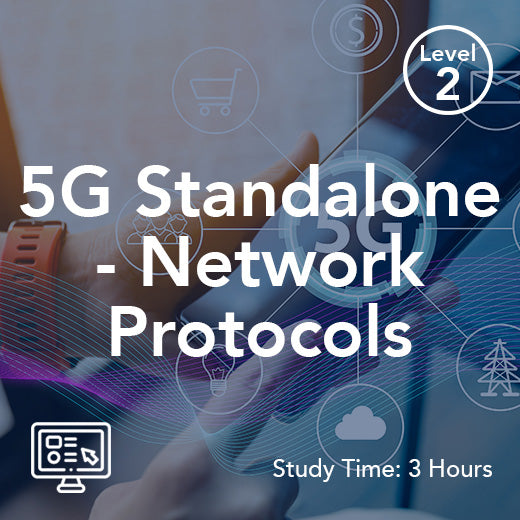
5G Standalone - Network Protocols (On-Demand)
Understanding the protocols that underpin 5G Standalone (SA) deployments is critical for anyone involved in mobile network design, deployment, or troubleshooting. This single-module course provides a practical overview of the key signalling and user plane protocols that enable communication within the 5G system. In just three hours, you'll explore how 5G SA uses modern service-based interfaces, with a focus on HTTP/2 and JSON for communication between core network functions. You'll also learn about protocol roles such as PFCP for user plane control, GTPv2-C for EPC interworking, and NAS protocols for direct signalling with the user equipment. The course also covers the essential signalling protocols in the NG-RAN, including NG-AP, Xn-AP, F1-AP, E1-AP, and RRC - critical for coordinating activity across the RAN and between the RAN and core. On the user plane, you’ll examine how data transport is managed using PDU sessions, and how session types (IP, Ethernet, Unstructured) are established and handled. You’ll also gain an understanding of QoS Flows, with parameters such as 5QI and ARP used to deliver differentiated service levels. This course is ideal for technical professionals who need a working knowledge of 5G SA protocol architecture, signalling behaviour, and data transport mechanisms - without going deep into packet-level analysis. Course Contents PDU Sessions and QoS Flows 5G QoS Parameters, ARP and 5QI Implementation of PDU Sessions IP PDU Session Types, IP Ethernet and Unstructured Multiple PDU Sessions Anchors Reflective QoS User Plane Protocol Stack Core Network Signalling Overview Hypertext Transfer Protocol (HTTP) HTTP 2 and JSON_2 Non-Access Stratum (NAS) and Access Stratum (AS) Protocols Next Generation Radio Access Network (NG-RAN) Signalling Protocols Overview RAN Protocols for the NG, FI, E1 and Xn Interfaces RAN User Plane Protocol
£95.00
-
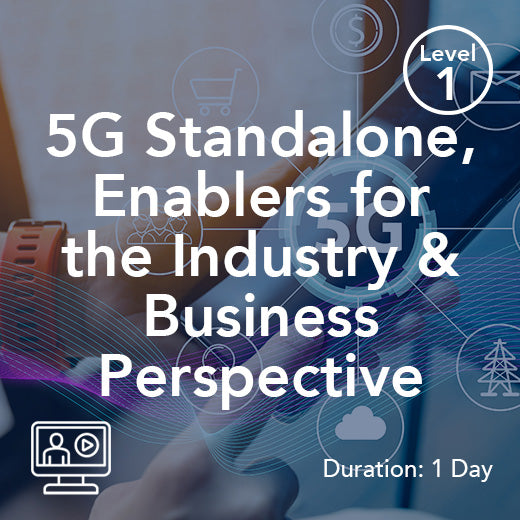
5G Standalone, Enablers for the Industry & Business Perspective
With SA 5G, we witness the evolution of mobile networks, from being reliant on legacy infrastructure, to achieving true independence - and unlocking unprecedented capabilities that enables 5G to support a much wider range of industrial use cases. In this course, we guide you through the benefits and challenges of deploying Standalone 5G, exploring its architectural advancements, unique features, and the benefits it brings to both consumers and businesses. We then highlight the enhanced capabilities and expanded use cases made possible by key technology enablers - including network slicing, edge computing, virtualization, non-terrestrial networks (NTNs), network exposure, and network automation. We discuss the impact of 5G SA for network operators, service providers, and enterprises - exploring the opportunities and challenges that arise in the deployment and management of advanced 5G networks. Who Would Benefit Ideal for anyone needing clarity on 5G trajectory – including capabilities & use cases Prerequisites A basic appreciation of the telecoms landscape – both technical and business Course Contents 5G Base Capabilities A Business Perspective 5G Standalone (SA) 5G Enablers for Industry
POA: Private Course
-
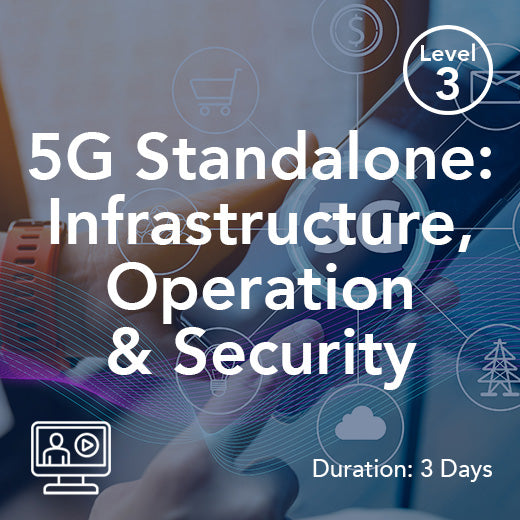
5G Standalone: Infrastructure, Operation & Security
Course Code: FG2301 One of the key requirements of 5G is its flexibility. Spectrum, Radio Interface configurations, RAN (Radio Access Network) deployment, Core Networks, and the mix of 4G and 5G used within the network are highly flexible – with much more flexible resource allocation compared to previous generations.Non-standalone (NSA) 5G made use of this flexibility by enabling 5G to effectively be an add-on to the public 4G LTE network; providing much-needed added capacity in specific locations (many of which were reaching maximum capacity), but continuing to make extensive use of existing 4G infrastructure and operations.As an Industry, we are now looking at full Standalone (SA) 5G – allowing us to gain the full benefits of 5G (in terms of better efficiency, latency, energy use, reliability etc). This means that we will need to transition to specific configurations and deployment options in order to allow full 5G operation. As an example, one of the conditions for SA 5G is that we use the new Service Based Architecture for the 5GC(5G Core).This programme focuses on the 5G system in the form of Standalone 5G (SA 5G), including the various configurations, procedures, and deployment options. Topic Areas Include: Introduction to 5G Principles of the 5G New Radio 5G Air Interface Radio Access Network Architecture Core Network Architecture Data Transport 5G Procedures 5G Security Architecture; and Authentication and Key Agreement Security and the Service Based Interface (including SEPP*) Releases 16 and 17 5G Protocols
£2,660.00





























































